Rear thigh muscles. Posterior Thigh Muscles: Anatomy, Function, and Clinical Relevance of Hamstrings
What are the main muscles that make up the hamstrings group. How do the hamstring muscles function in leg movement. What are common injuries affecting the posterior thigh muscles. How can damage to the hamstrings be prevented and treated.
Anatomy of the Posterior Thigh Muscles
The posterior compartment of the thigh contains a group of muscles collectively known as the hamstrings. This muscle group consists of three main muscles:
- Biceps femoris
- Semitendinosus
- Semimembranosus
These muscles originate from the ischial tuberosity of the pelvis and insert into the proximal parts of the tibia and fibula. The hamstrings cross both the hip and knee joints, allowing them to play a crucial role in lower limb movements.
Biceps Femoris
The biceps femoris is the most lateral of the hamstring muscles and consists of two heads:
- Long head – originates from the ischial tuberosity
- Short head – originates from the linea aspera on the posterior surface of the femur
Both heads form a common tendon that inserts into the head of the fibula. The long head is innervated by the tibial part of the sciatic nerve, while the short head receives innervation from the common fibular part.
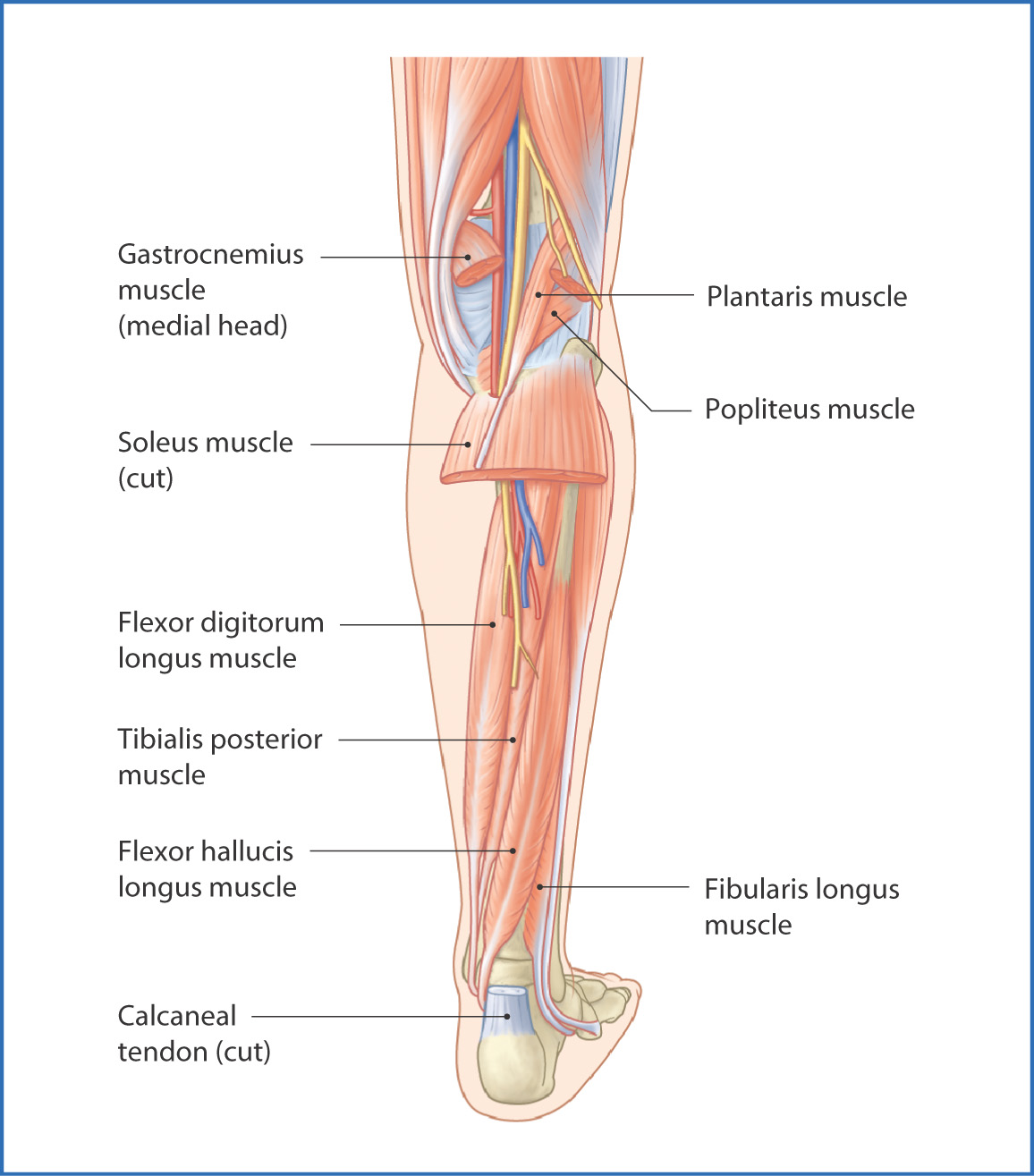
Semitendinosus
The semitendinosus is a largely tendinous muscle located medially to the biceps femoris. It originates from the ischial tuberosity and attaches to the medial surface of the tibia. This muscle is innervated by the tibial part of the sciatic nerve.
Semimembranosus
The semimembranosus is a flattened, broad muscle located underneath the semitendinosus. It originates from the ischial tuberosity, superior to the attachments of the semitendinosus and biceps femoris. The semimembranosus attaches to the medial tibial condyle and receives innervation from the tibial part of the sciatic nerve.
Functions of the Hamstring Muscles
The hamstring muscles perform several important functions in lower limb movement:
- Hip extension
- Knee flexion
- Medial and lateral rotation of the thigh and leg
How do these muscles contribute to different movements? The primary actions of the hamstrings include:
- Extending the thigh at the hip joint
- Flexing the leg at the knee joint
- Medially rotating the thigh at the hip joint (semitendinosus and semimembranosus)
- Laterally rotating the thigh at the hip joint (biceps femoris)
- Medially rotating the leg at the knee joint (semitendinosus and semimembranosus)
- Laterally rotating the leg at the knee joint (biceps femoris)
These actions allow for a wide range of movements, including walking, running, jumping, and maintaining balance while standing.

Innervation and Blood Supply
The hamstring muscles receive their innervation from the sciatic nerve, which originates from the sacral plexus (L4-S3). Specifically:
- The tibial part of the sciatic nerve innervates the long head of the biceps femoris, semitendinosus, and semimembranosus
- The common fibular (peroneal) part of the sciatic nerve innervates the short head of the biceps femoris
As for blood supply, the hamstrings receive their vascular supply primarily from the deep femoral artery and its perforating branches.
Clinical Relevance: Hamstring Injuries and Their Management
Hamstring injuries are common, especially among athletes involved in sports that require rapid acceleration, deceleration, and changes in direction. These injuries can range from mild strains to complete muscle tears.
Types of Hamstring Injuries
The most common types of hamstring injuries include:
- Muscle strains
- Tendon avulsions
- Contusions
Muscle strains occur when the muscle fibers are stretched beyond their capacity, leading to partial or complete tears. Tendon avulsions happen when the hamstring tendon is forcefully pulled away from its attachment site, sometimes taking a piece of bone with it. Contusions are typically caused by direct blows to the muscle.
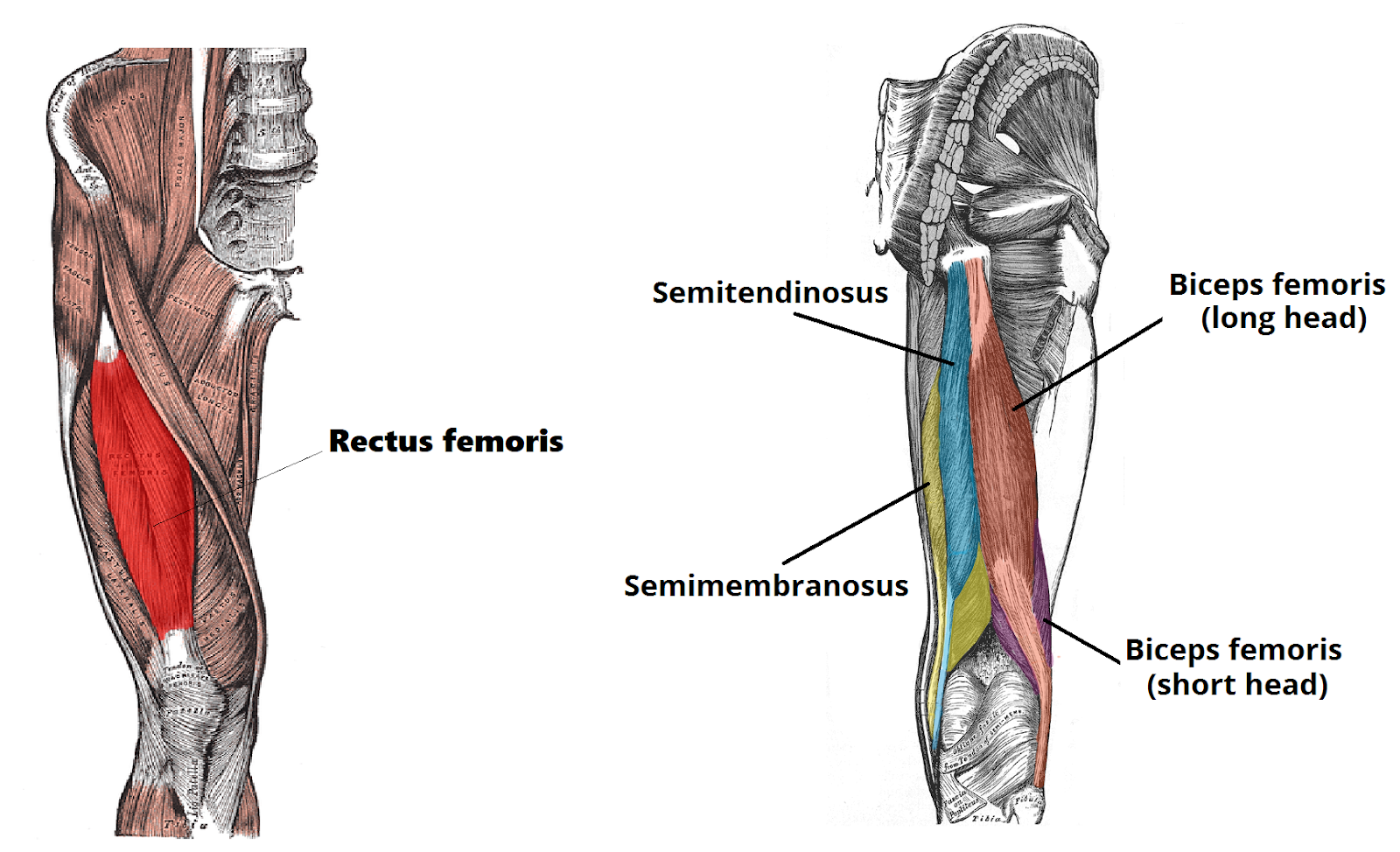
Diagnosis and Treatment
How are hamstring injuries diagnosed and treated? The diagnosis typically involves:
- Physical examination
- Imaging studies (MRI or ultrasound)
Treatment for hamstring injuries often follows the RICE protocol:
- Rest
- Ice
- Compression
- Elevation
In addition to RICE, treatment may include:
- Pain management
- Physical therapy
- Gradual return to activity
In severe cases, such as complete tendon avulsions, surgical intervention may be necessary.
Prevention of Hamstring Injuries
Preventing hamstring injuries is crucial, especially for athletes and active individuals. What are some effective strategies for hamstring injury prevention?
- Proper warm-up before physical activity
- Regular stretching and flexibility exercises
- Strengthening exercises targeting the hamstrings and surrounding muscles
- Maintaining proper running form and technique
- Gradually increasing training intensity and volume
- Adequate rest and recovery between training sessions
Implementing these preventive measures can significantly reduce the risk of hamstring injuries and improve overall performance.
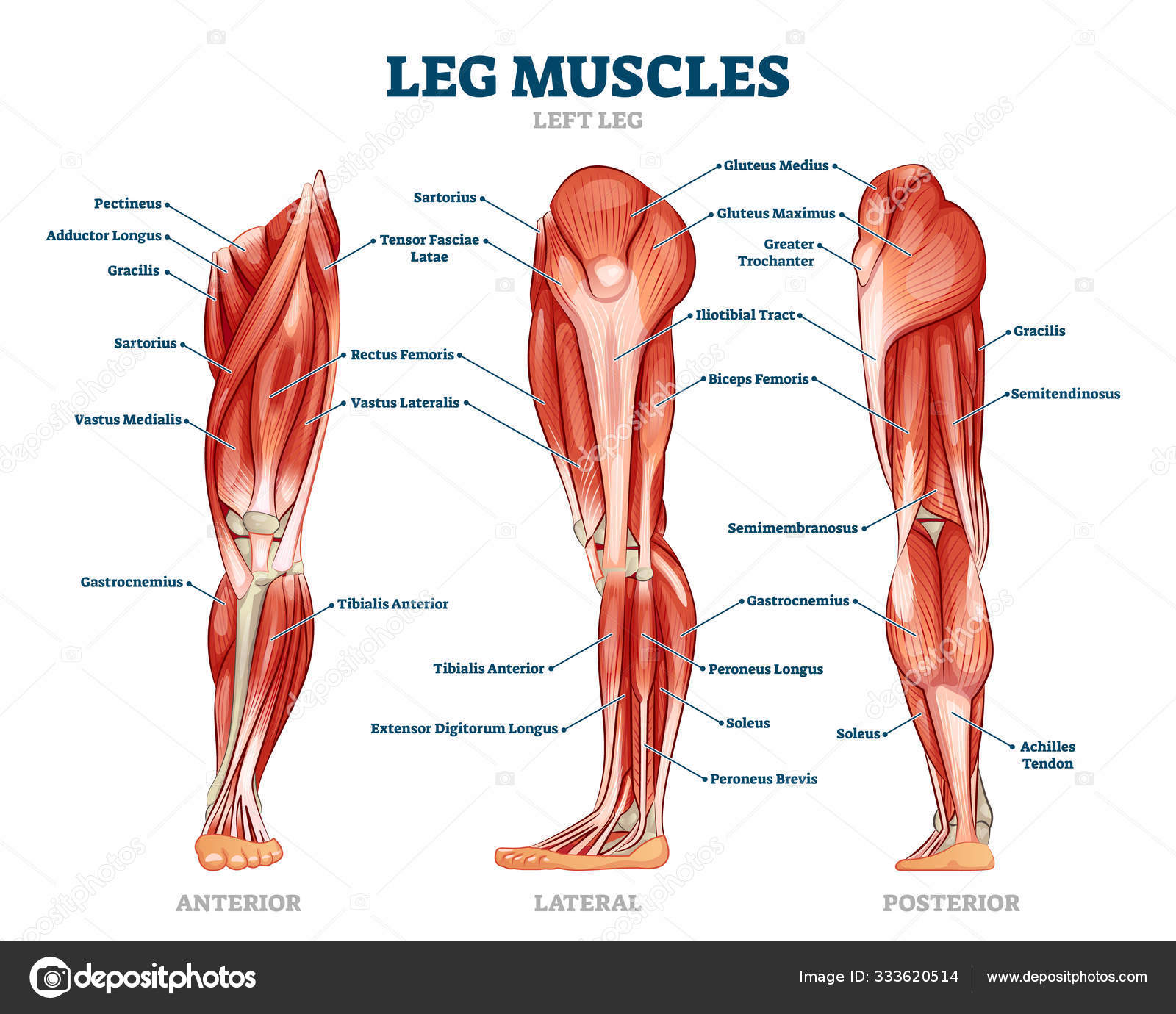
Rehabilitation and Return to Activity
Rehabilitation after a hamstring injury is crucial for a full recovery and safe return to activity. The rehabilitation process typically involves:
- Initial rest and protection of the injured area
- Gradual restoration of range of motion
- Progressive strengthening exercises
- Functional training specific to the individual’s sport or activity
- Return-to-play testing and clearance
The duration of rehabilitation can vary depending on the severity of the injury, but it generally ranges from a few weeks for minor strains to several months for more severe injuries.
Anatomical Variations and Their Clinical Significance
While the basic anatomy of the hamstring muscles is consistent across individuals, there can be variations in muscle architecture, attachment sites, and innervation patterns. These variations may have clinical implications, such as:
- Differences in muscle strength and function
- Variations in injury patterns and healing rates
- Potential challenges in surgical interventions
Understanding these anatomical variations is important for healthcare professionals involved in the diagnosis, treatment, and rehabilitation of hamstring injuries.

Advanced Imaging Techniques for Hamstring Evaluation
Modern imaging techniques play a crucial role in the assessment and management of hamstring injuries. What are some of the advanced imaging modalities used in evaluating hamstring muscles?
- Magnetic Resonance Imaging (MRI): Provides detailed soft tissue images, allowing for precise injury grading and localization
- Ultrasound: Offers real-time, dynamic assessment of muscle function and can guide interventional procedures
- Elastography: Measures tissue stiffness, which can be useful in assessing muscle healing and readiness for return to activity
These imaging techniques not only aid in diagnosis but also help in monitoring the healing process and guiding treatment decisions.
The posterior thigh muscles, or hamstrings, are a crucial muscle group for lower limb function and movement. Their complex anatomy and biomechanics make them susceptible to various injuries, particularly in athletic populations. Understanding the structure, function, and clinical relevance of these muscles is essential for healthcare professionals, athletes, and fitness enthusiasts alike. By implementing proper prevention strategies, accurate diagnosis, and effective rehabilitation protocols, the impact of hamstring injuries can be minimized, allowing individuals to maintain optimal performance and quality of life.

Muscles of the Posterior Thigh – Hamstrings – Damage
The muscles in the posterior compartment of the thigh are collectively known as the hamstrings. They consist of the biceps femoris, semitendinosus and semimembranosus, which form prominent tendons medially and laterally at the back of the knee.
As group, these muscles act to extend at the hip, and flex at the knee. They are innervated by the sciatic nerve (L4-S3).
In this article, we shall examine the anatomy of the muscles in the posterior thigh – their attachments, innervation and actions.
Muscles in the Posterior Compartment
The muscles located within the posterior compartment of the thigh are the biceps femoris, semitendinosus and semimembranosus.
Note: The hamstring portion of the adductor magnus has a similar action to these muscles, but is located in the medial thigh.
Biceps Femoris
Like the biceps brachii in the arm, the biceps femoris muscle has two heads – a long head and a short head.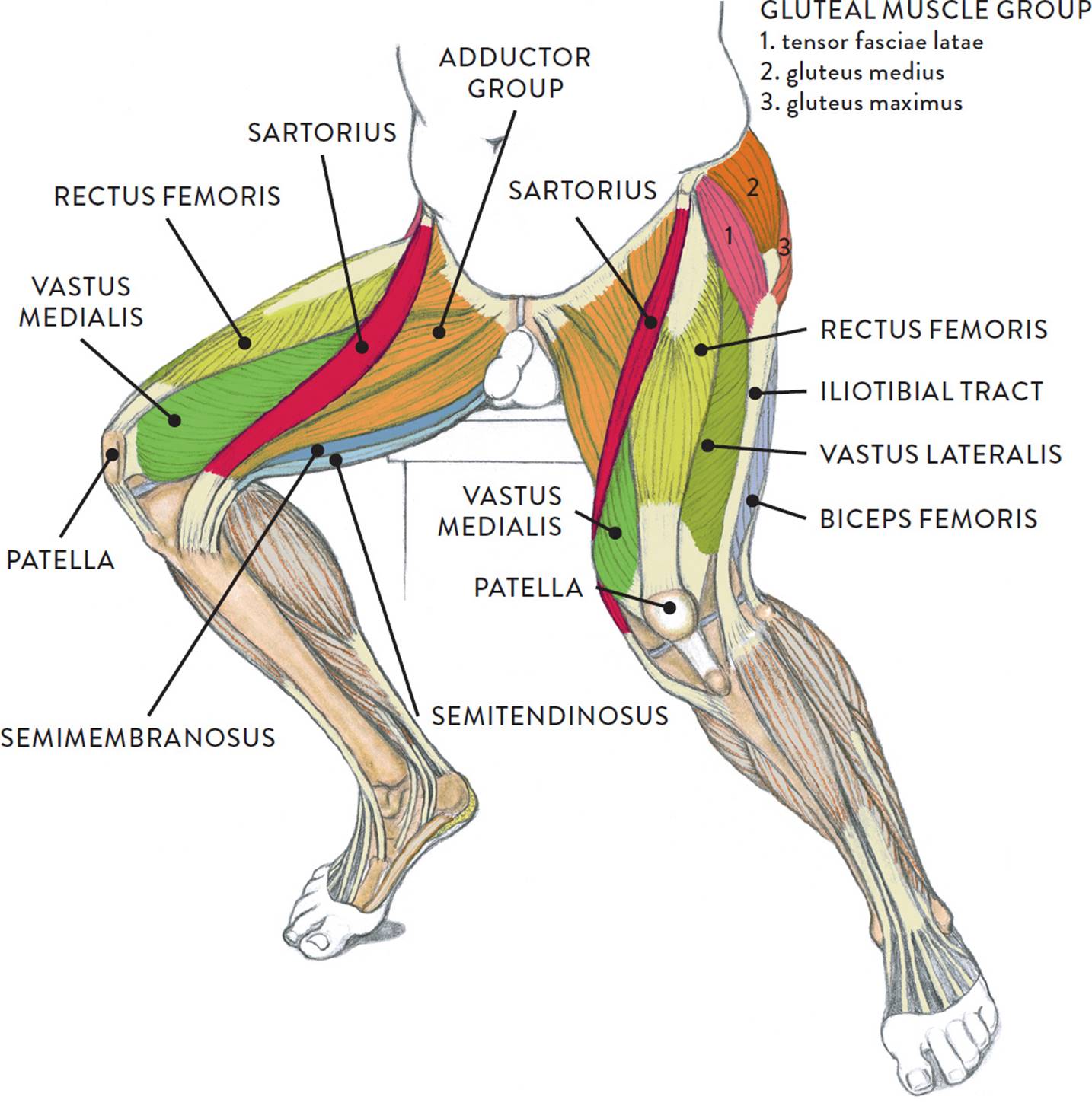
It is the most lateral of the muscles in the posterior thigh – the common tendon of the two heads can be felt laterally at the posterior knee.
- Attachments: The long head originates from the ischial tuberosity of the pelvis. The short head originates from the linea aspera on posterior surface of the femur. Together, the heads form a tendon, which inserts into the head of the fibula.
- Actions: Main action is flexion at the knee. It also extends the thigh at the hip, and laterally rotates at the hip and knee.
- Innervation: Long head innervated by the tibial part of the sciatic nerve, whereas the short head is innervated by the common fibular part of the sciatic nerve.
Semitendinosus
The semitendinosus is a largely tendinous muscle. It lies medially to the biceps femoris, and covers the majority of the semimembranosus.
- Attachments: It originates from the ischial tuberosity of the pelvis, and attaches to the medial surface of the tibia.

- Actions: Flexion of the leg at the knee joint. Extension of thigh at the hip. Medially rotates the thigh at the hip joint and the leg at the knee joint.
- Innervation: Tibial part of the sciatic nerve.
Semimembranosus
The semimembranosus muscle is flattened and broad. It is located underneath the semitendinosus.
- Attachments: It originates from the ischial tuberosity, but does so more superiorly than the semitendinosus and biceps femoris. It attaches to the medial tibial condyle.
- Actions: Flexion of the leg at the knee joint. Extension of thigh at the hip. Medially rotates the thigh at the hip joint and the leg at the knee joint.
- Innervation: Tibial part of the sciatic nerve.
Fig 1 – The muscles of the posterior thigh.
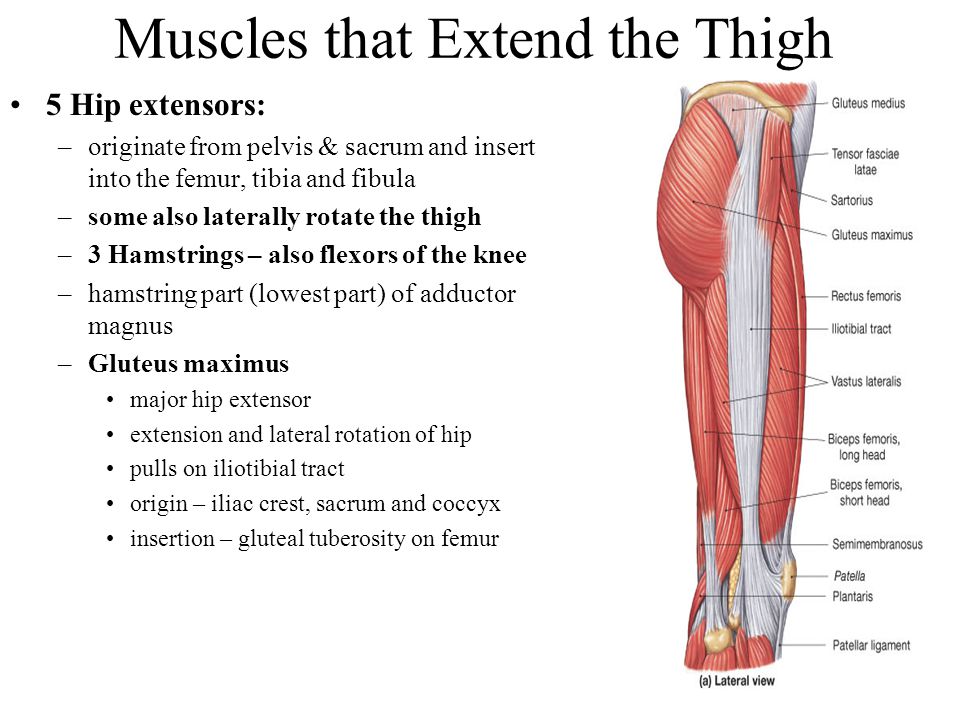
[start-clinical]
Clinical Relevance: Damage to the Hamstrings
Muscle Strain
A hamstring strain refers to excessive stretch or tearing of the muscle fibres. They are often seen athletes involved in running or kicking sports. Damage to the muscle fibres is likely to rupture the surrounding blood vessels – producing a haematoma (a collection of blood). The haematoma is contained by the overlying fascia lata.
Treatment of any muscle strain should utilise the RICE protocol – rest, ice, compression and elevation.
Avulsion Fracture of the Ischial Tuberosity
An avulsion fracture occurs when a fragment of bone breaks away from the main body of bone.
In an avulsion fracture of the ischial tuberosity, the hamstring tendons ‘tear off’ a piece of the ischial tuberosity. Such an injury usually occurs in sports that require rapid contraction and relaxation of the muscles – such as sprinting, football and hurdling.
[end-clinical]
Posterior thigh muscles – Hamstrings
Posterior thigh muscles (hamstrings): want to learn more about it?
Our engaging videos, interactive quizzes, in-depth articles and HD atlas are here to get you top results faster.
What do you prefer to learn with?
“I would honestly say that Kenhub cut my study time in half.”
–
Read more.
Kim Bengochea, Regis University, Denver
Author:
Roberto Grujičić MD
•
Reviewer:
Jana Vasković
Last reviewed: April 08, 2021
Reading time: 8 minutes
Posterior thigh muscles (Hamstring muscles)
The hamstring muscles, or simply the hamstrings, are a group of three long muscles located in the posterior compartment of the thigh, shaping up the surface anatomy of this region. These muscles are the biceps femoris, semimembranosus and semitendinosus muscles.
These muscles are the biceps femoris, semimembranosus and semitendinosus muscles.
The hamstrings are closely related to each other as they share a common origin point, and they all attach to the proximal parts of the tibia and fibula. They are innervated by the tibial and common fibular (peroneal) divisions of the sciatic nerve (L4-S3).
All the hamstring muscles cross the hip and knee joints and act upon them. The primary function of the hamstrings is to flex the knee joint and extend the hip, enabling some of the essential lower limb activities such as walking, running, and climbing. The hamstrings have an important stabilizing function as well; they are inactive when the bodyweight is equally distributed between both lower limbs in a standing position. However, when a person starts tilting forward, these muscles activate and counteract the tilting movement in order to stabilize the hip joint and prevent falling. Also, due to the location of their insertions, the hamstrings act together with the collateral ligaments to stabilize the knee joint.
Also, due to the location of their insertions, the hamstrings act together with the collateral ligaments to stabilize the knee joint.
This article will introduce you to the anatomy and function of the hamstring muscles.
| Definition and function | The hamstrings are the muscles of the posterior thigh that are primarily in charge of knee flexion and thigh extension |
| Muscles | Biceps femoris, semimembranosus, semitendinosus |
| Innervation | Tibial and common fibular (peroneal) divisions of the sciatic nerve |
| Primary functions | Flexion of leg, extension of thigh, stabilization of knee and hip joints |
Biceps femoris muscle
Biceps femoris is a two-headed muscle that runs superficially through the posterior thigh.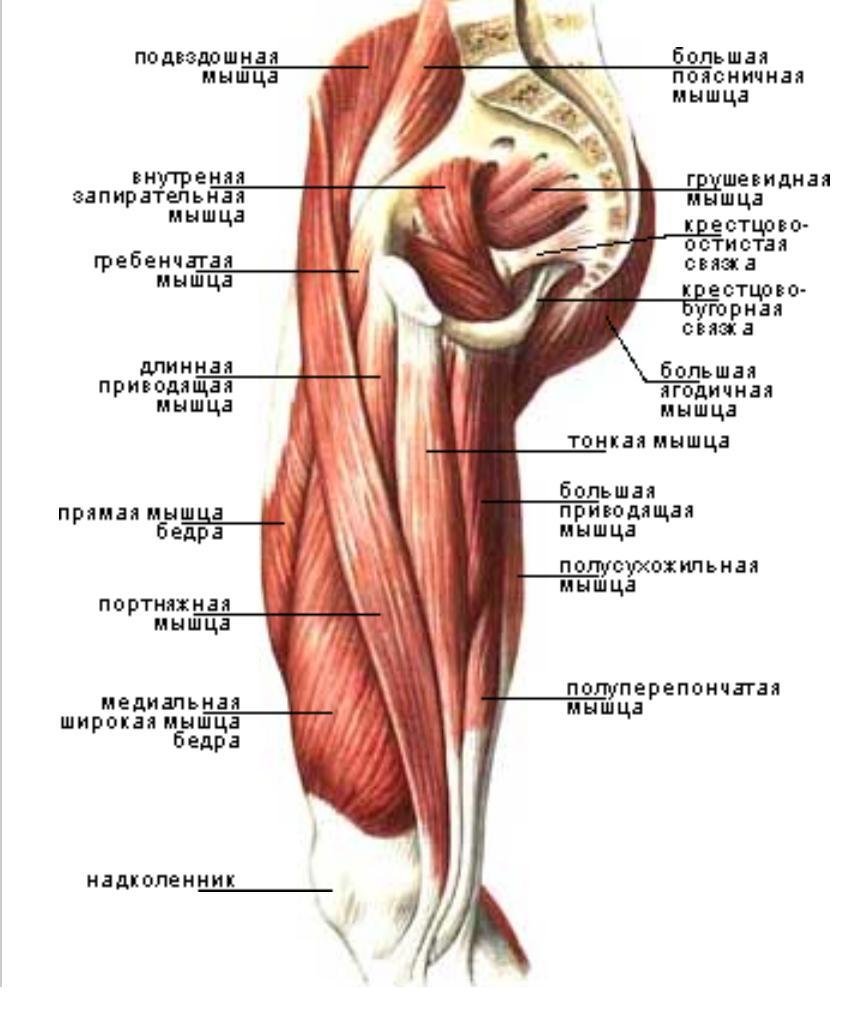 Each head of biceps femoris has its own origin and supply, but they share the common insertion. The long head of biceps femoris arises from the ischial tuberosity and sacrotuberous ligament. The short head arises from the lateral lip of the linea aspera and lateral supracondylar line of femur. The muscle fibers from both heads converge and form the conjoint aponeurotic sheet that inserts onto the head of fibula.
Each head of biceps femoris has its own origin and supply, but they share the common insertion. The long head of biceps femoris arises from the ischial tuberosity and sacrotuberous ligament. The short head arises from the lateral lip of the linea aspera and lateral supracondylar line of femur. The muscle fibers from both heads converge and form the conjoint aponeurotic sheet that inserts onto the head of fibula.
The long head of biceps femoris is innervated by the tibial division of sciatic nerve, while the short head receives the nerve supply from the common fibular division of sciatic nerve.
The long head of biceps femoris acts upon two joints (hip and knee), while the short head acts only on the knee joint. Firstly, the long head contributes to the extension of the hip. This action is particularly strong when the flexed trunk is being raised to the erect position.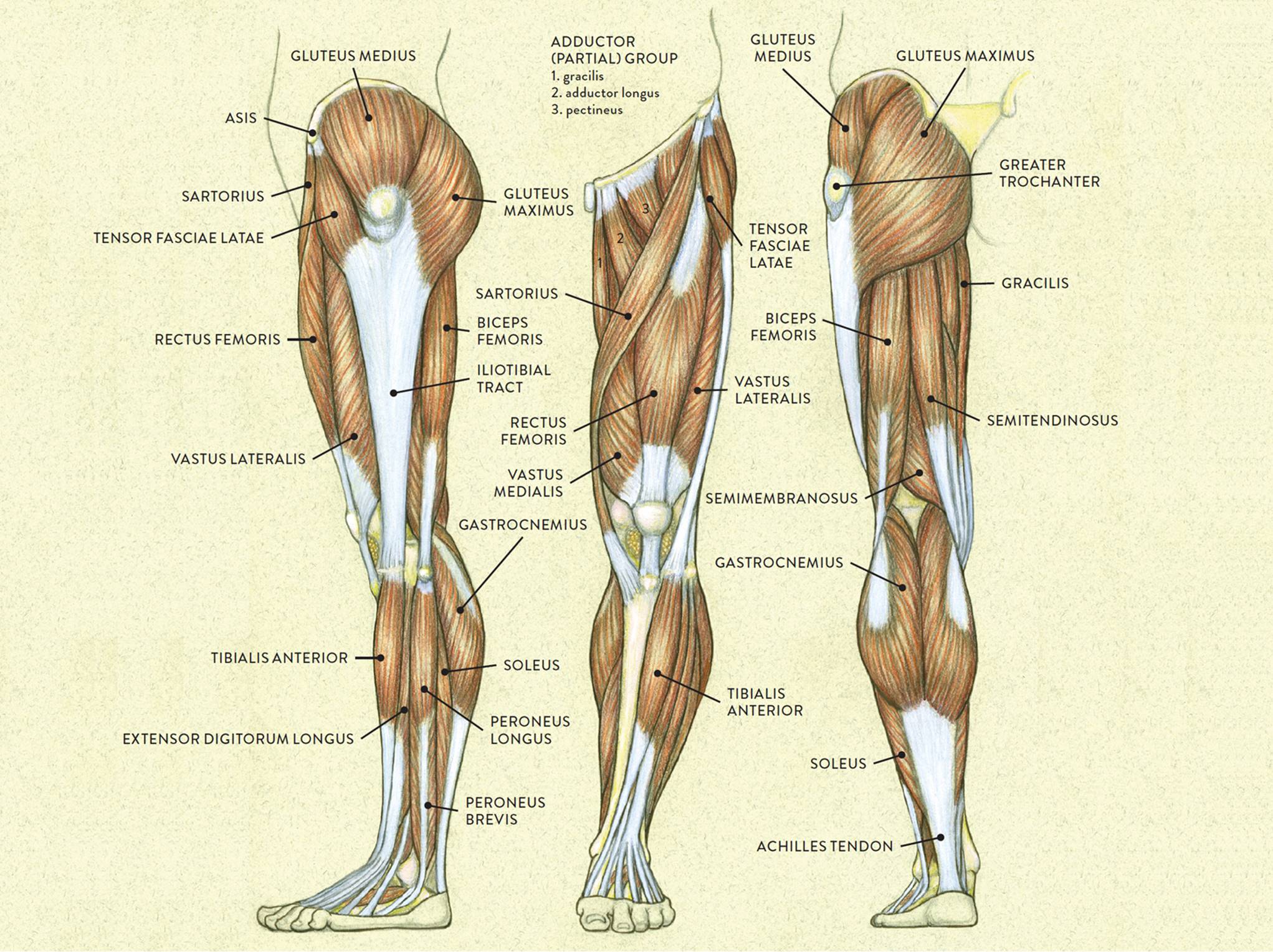 Both heads of biceps femoris contribute to the flexion of the leg in the knee joint. Additionally, biceps femoris can act as the external rotator of the leg when the knee is semi flexed or internal rotator of the thigh if the foot is fixed on the surface.
Both heads of biceps femoris contribute to the flexion of the leg in the knee joint. Additionally, biceps femoris can act as the external rotator of the leg when the knee is semi flexed or internal rotator of the thigh if the foot is fixed on the surface.
Start with the anatomy of the hip and thigh muscles by exploring our videos, quizzes, labeled diagrams, and articles.
Semimembranosus muscle
Semimembranosus is a fusiform muscle of the posterior thigh. It runs deep to semitendinosus and medial to biceps femoris. Semimembranosus originates from the ischial tuberosity of pelvis and inserts into the medial condyle of tibia.
Are you feeling a bit overwhelmed? Learn the attachments, innervations and functions of the hamstring muscles faster and easier with our muscle charts!
Semimembranosus is innervated by the tibial division of the sciatic nerve.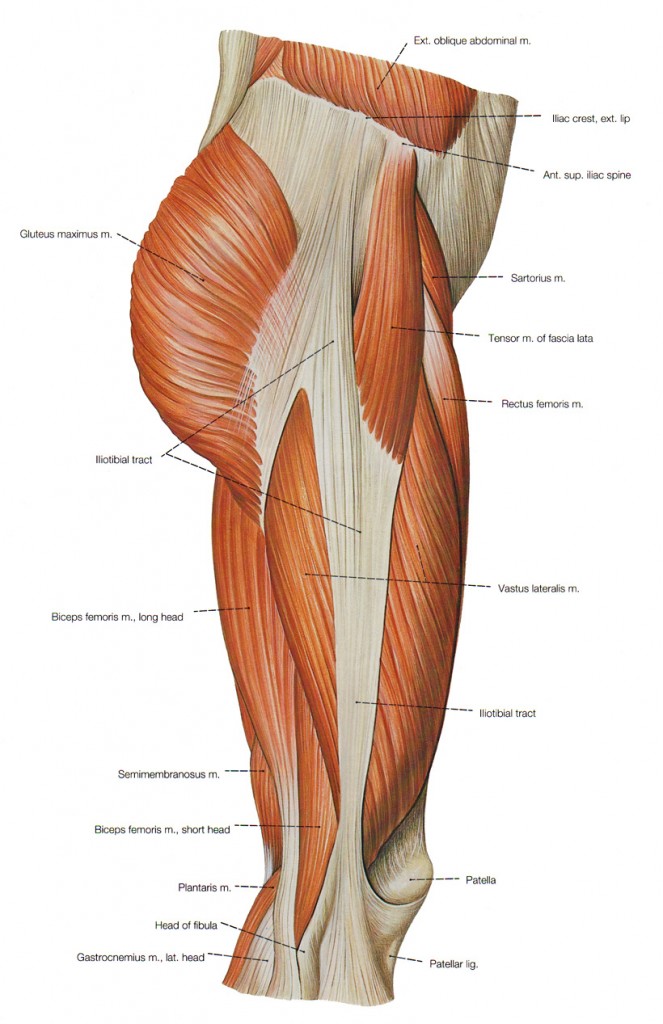 The blood supply for this muscle comes from the femoral and popliteal arteries.
The blood supply for this muscle comes from the femoral and popliteal arteries.
Like the other muscles from this group, semimembranosus also acts on both knee and hip joints. Its functions mainly depend on the initial position of the lower extremity. When the foot is firmly placed on the ground, semimembranosus extends the hip, bringing the trunk into an erect position. In contrast, when the foot is elevated, semimembranosus flexes and internally rotates the leg. Additionally, when the hip is in full extension, semimembranosus causes internal rotation of the hip.
Semitendinosus muscle
Semitendinosus is a long, fusiform muscle that runs in the posterior thigh, medially to biceps femoris. More specifically, it extends from the ischial tuberosity of bony pelvis to the proximal end of the tibia below medial condyle, where it inserts via the pes anserinus.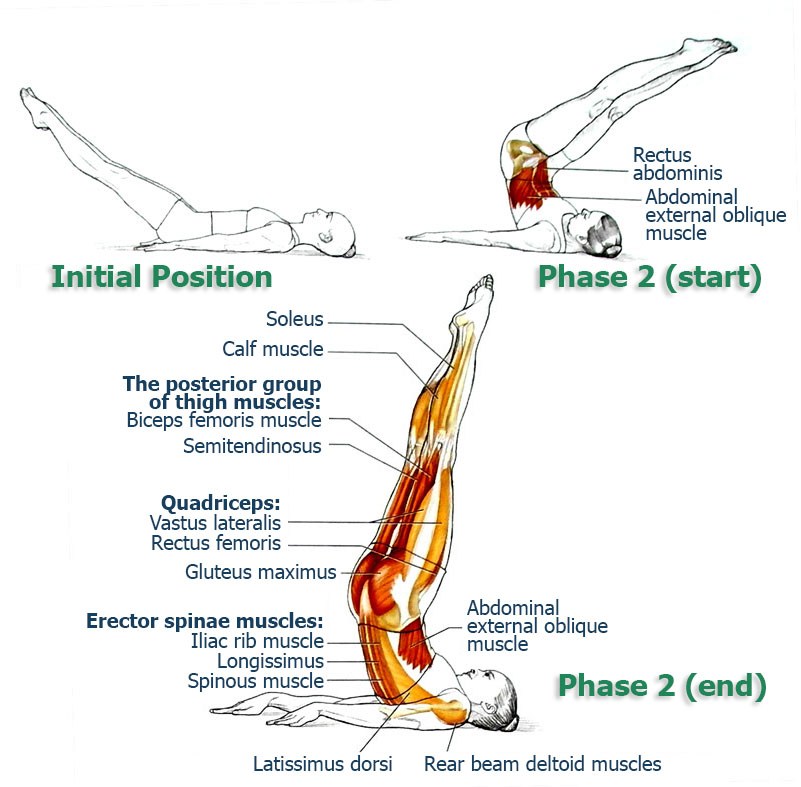
Semitendinosus receives its innervation through the tibial division of sciatic nerve. It is vascularized by the deep femoral (profunda femoris) and medial circumflex femoral arteries.
Similar to semimembranosus, the actions of semitendinosus on hip and knee joints mainly depend on the body position. When the trunk is erect, semitendinosus acts as an internal rotator of the thigh. While on the other hand, when the trunk is flexed anteriorly, it extends the thigh.
At the knee joint, semitendinosus primarily flexes the leg and stabilizes the knee joint. Additionally, when the knee is semiflexed, it contributes to the internal rotation of the leg.
Are you here to solidify and test your knowledge on the posterior thigh muscles? Try out our quiz!
Clinical notes
Strains
The power of the hamstrings is clinically tested by active flexion of the knee against resistance.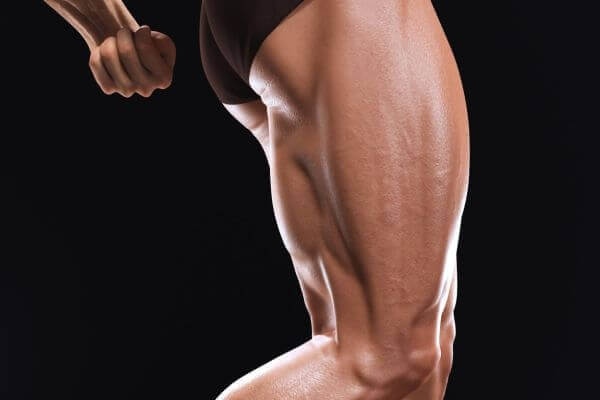 The power of the individual hamstring tendons can be assessed more accurately whilst the subject is prone. A strain or tear of the hamstrings, sometimes known as a pulled or torn hamstring is a common sports injury in individuals who are required to start and stop often or run very hard e.g. in those who play basketball and football etc.
The power of the individual hamstring tendons can be assessed more accurately whilst the subject is prone. A strain or tear of the hamstrings, sometimes known as a pulled or torn hamstring is a common sports injury in individuals who are required to start and stop often or run very hard e.g. in those who play basketball and football etc.
Avulsions
An avulsion or a tear may occur when an individual violently exerts a muscle. This commonly causes the proximal tendons to tear away from the ischial tuberosity, resulting in bruising (or a contusion), muscle fibre tears and blood vessel rupture which produces a haematoma. Tearing of the hamstring muscle fibres usually results in a sharp, intense pain. Stretching and adequate warming up help prevent this injury.
Posterior thigh muscles (hamstrings): want to learn more about it?
Our engaging videos, interactive quizzes, in-depth articles and HD atlas are here to get you top results faster.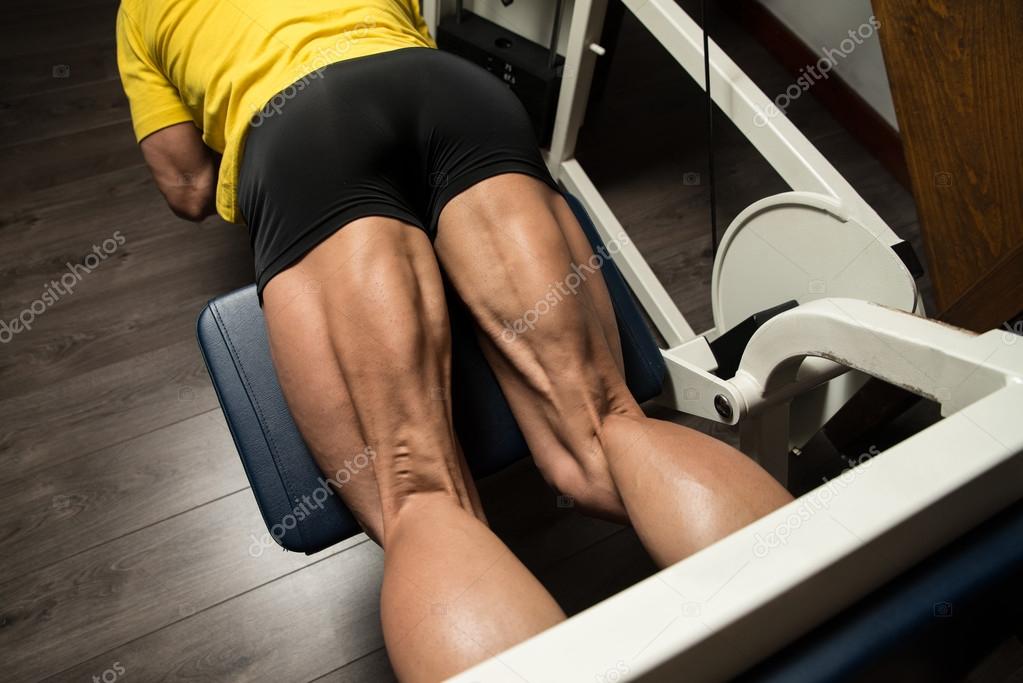
What do you prefer to learn with?
“I would honestly say that Kenhub cut my study time in half.”
–
Read more.
Kim Bengochea, Regis University, Denver
Muscles of the hips and thighs
Information
There are three layers of gluteal muscles on the posterior hips, just like there are three layers of muscles in the abdominal trunk. The largest of them is the most superficial muscle, the gluteus maximus. Its origin is on the ilium of the coxal bone, and it inserts part-way down the shaft of the femur. It helps maintain erect posture, abducts the thigh, and rotates the thigh outward.
Below the gluteus maximus is the smaller gluteus medius. The gluteus medius muscle helps abducts the thigh along with the gluteus maximus, but can rotate the thigh inward where the gluteus maximus rotates the thigh outward.
The below the gluteus medius are several muscles, one of which is the gluteus minimus, the smallest of the gluteal muscles. It is a synergist for the gluteus medius.
It is a synergist for the gluteus medius.
Figure 9-7. The three layers of gluteal muscles, gluteus maximus, gluteus medius, gluteus minimus.
Like the forearm, the upper leg, or thigh, has a dense arrangement of many muscles. On the anterior side, the most prominent of the muscles are the sartorius muscle and the four muscles that make up quadriceps muscle group (the “quads”.)
The quadriceps sounds like it should be just one muscle, akin to the triceps brachii, but it is a group of four muscles, three visible on the surface, and the fourth obscured. The three surface muscles of the quadriceps are the rectus femoris in the center, the vastus medialis on the medial side, and the vastus lateralis on the lateral side. These three muscles are visible in Figure 9-8. Below the rectus femoris and largely hidden by it is the vastus intermedius. This muscle’s position can be seen in Figure 9-9.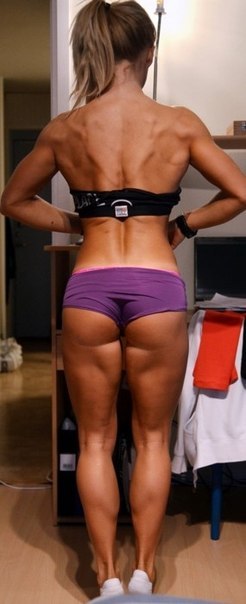 The four muscle of the quadriceps all extend the lower leg, and the rectus femoris additionally can flex the thigh at the hip.
The four muscle of the quadriceps all extend the lower leg, and the rectus femoris additionally can flex the thigh at the hip.
Figure 9-8. The superficial muscles of the thigh.
Figure 9-9. The quadriceps group of four muscles. The view on the left has the rectus femoris cut away to show the vastus intermedius which is below it.
The sartorius muscle is a distinctively long and thin muscle that crosses the thigh diagonally. It is visible in Figure 9-8. Sartorius comes from the Latin for tailor, and this is sometimes called the tailor’s muscle, although the reasons for the nickname are obscure. It may be because the shape of the muscle is thin and long, like a tailor’s measuring tape; it may be because it is close to the inseam a tailor measures when tailoring pants, or it may be because it helps bring about the cross-legged position that tailors often adopt when working.
In the posterior thigh the bulk of the musculature is made up of three long muscles that are collectively called the hamstrings. The origin of this nickname is obscure, but it may have to do with the practice of butchers of hanging the thighs of butchered animals such as pig (the “hams”) by the tendons of these three muscles. Move from the medial edge to the lateral edge of the posterior thigh, the hamstring muscles are the semimembranous muscle, the semitendinosus muscle, and the biceps femoris muscle. Notice the upper leg has a “biceps” muscle just like the upper arm does. This is why you have to indicate which biceps you are taking about when discussing one or other of these muscles. On the medial edge of the posterior thigh is the gracilis muscle. It is also visible on the medial edge of the thigh from the anterior.
The origin of this nickname is obscure, but it may have to do with the practice of butchers of hanging the thighs of butchered animals such as pig (the “hams”) by the tendons of these three muscles. Move from the medial edge to the lateral edge of the posterior thigh, the hamstring muscles are the semimembranous muscle, the semitendinosus muscle, and the biceps femoris muscle. Notice the upper leg has a “biceps” muscle just like the upper arm does. This is why you have to indicate which biceps you are taking about when discussing one or other of these muscles. On the medial edge of the posterior thigh is the gracilis muscle. It is also visible on the medial edge of the thigh from the anterior.
Figure 9-10. The muscles of the posterior thigh.
Figure 9-11. The hamstring group of muscles of the posterior thigh.
Lab 9 Exercises 9.4
- Using the full-scale leg model, locate and identify the muscles of the thigh listed in the table below.

- Write down the muscles of the thigh in the table below and, for each, give the location of that muscle and what effect contracting that muscle has.
| Muscle | Location & description | Action(s) |
| Rectus femoris |
| |
| Vastus intermedius |
| |
| Vastus medialis |
| |
| Vastus lateralis |
| |
| Sartorius |
| |
| Gracilis |
| |
| Semimembranosus |
| |
| Semitendinosus |
| |
| Biceps femoris |
|
Posterior Thigh Pain – Injuries causing pain at the back of the Thigh
Pain at the back of the thigh is known as posterior thigh pain.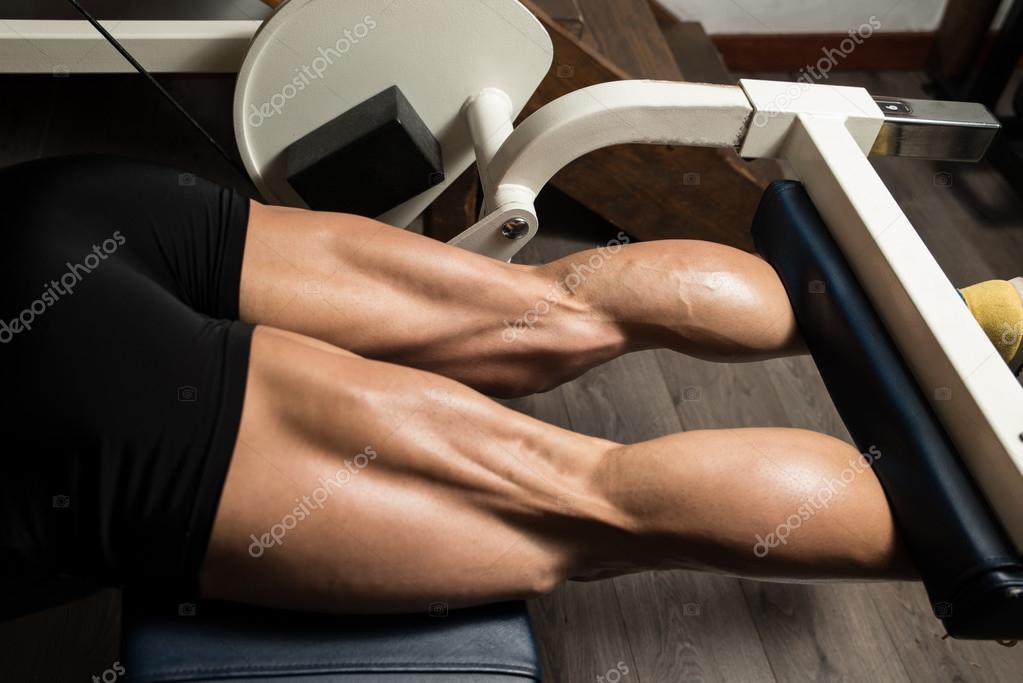 Here we explain the common, and less common injuries and causes of hamstring/back of the thigh pain.
Here we explain the common, and less common injuries and causes of hamstring/back of the thigh pain.
Did your injury occur suddenly, or develop gradually over time?
Sudden onset/acute
Gradual onset/chronic
Symptom Checker
Sudden onset/acute posterior thigh pain
The following are causes of sudden onset or acute pain at the back of the thigh:
Pulled hamstring/hamstring strain
A hamstring strain or pulled hamstring is very common in sport. It usually occurs from sprint related activities, or when performing high kicks and overstretching the hamstring muscles. Symptoms include:
- Sudden onset pain at the back of the thigh.
- Hamstring strains are graded one to three depending on how bad they are.
- A mild strain can simply be tightness in the muscle.
- If you have a more severe strain then you will be unable to continue playing and may have suffered is a partial or even complete rupture of the muscle.

More on Hamstring strain
Cramp in the hamstrings
Cramp is a painful contraction of the muscle that happens involuntarily and is very common in the hamstring muscles. Symptoms consist of:
- A sudden involuntary spasm of the hamstring muscles.
- Significant pain.
- You will find it very difficult to relax the muscle on your own.
- Cramp is most likely to occur following a bout of hard, unacustomed exercise.
More on Cramp
Hamstring contusion
A hamstring muscle contusion involves a direct blow to the back of the thigh. Symptoms include:
- Pain at the back of the thigh, particularly at the point of impact.
- There may or may not be noticeable swelling depending on how bad your injury is.
- Bruising also may or may not develop. This will depend on the type of contusion and whether the muscle fascia has been damaged.
- If bleeding is contained within the muscle then bruising will not be visible, but these injuries may take longer to heal.

More on Contusions
Hamstring tendon avulsion
An avulsion strain occurs when the tendon tears pulling a small part of the bone away with it.
- This is more common in younger athletes (14-18-year-olds) and older people who may have had a history of chronic hamstring tendinitis.
- A young athlete with severe hamstring pain at the point of origin should always be suspected of having an avulsion strain.
- An X-ray or bone scan will be needed to confirm the diagnosis.
More on Hamstring tendon avulsion
Gradual onset/chronic posterior thigh pain
The following are causes of pain at the back of thigh which occurs gradually over time as opposed to a sudden ‘pull’ or muscle strain:
Referred hamstring pain
Pain in the hamstring region can actually originate from the lower back, sacroiliac joints or muscles of the buttocks such as the gluteus maximus and piriformis muscle. Symptoms include:
Symptoms include:
- Pain at the back of the leg which may be sudden onset gradual.
- Pain is usually less severe than a hamstring strain although twinges may be felt.
- The slump test to test tension in the sciatic nerve is likely to be positive, but not in all cases.
More on Referred pain
Ischioglutealbursitis/tendinopathy
Hamstring tendonitis (or tendinopathy) can occur at the origin of the hamstring muscles, specifically at the ischial tuberosity. Bursitis is inflammation of the small sac of fluid between the tendon and bone. It is often difficult to distinguish between the two. Symptoms include:
- Pain just under the crease of the buttocks.
- You may have tenderness and thickening of the tendon at the site of pain.
- Hamstring tendinitis in the buttocks may be caused by overuse.
- Ischiogluteal bursitis is inflammation of the bursa (small sack of fluid) which sits between the tendon and bone.

More on Ischiogluteal bursitis/tendinopathy
Tight hamstring muscles
Although not a specific injury, nor a cause of posterior thigh pain, tight hamstring muscles are common. Most of the time will not cause a problem. However, they may be more prone to severe strains or contribute to other problems such as back pain and postural issues. Tight hamstrings mean you can’t train and compete at full capacity as the muscles aren’t fully healthy.
More on tight hamstrings
Posterior compartment syndrome
Compartment syndrome occurs when the muscle swells up too big for the sheath that surrounds it causing pressure and pain. Symptoms include:
- A dull pain in the back of the thigh, cramp, and weakness.
- It is caused either by overuse as might be seen in endurance runners or repeated trauma from redcurrant hamstring strains.
- Surgery is thought to be the most effective form of treatment.
Other injuries causing posterior thigh pain
Other injuries causing pain at the back of the thigh which should not be missed include Myositis ossificans, Tumors, and Iliac artery
Futher information & research
- Posterior Thigh Muscle Injuries in Elite Track and Field Athletes.
 Nikolaos Malliaropoulos, MD, MSc, PhD, Emmanuel Papacostas, MD, Olga Kiritsi, MD, Am.J.SportsMed.
Nikolaos Malliaropoulos, MD, MSc, PhD, Emmanuel Papacostas, MD, Olga Kiritsi, MD, Am.J.SportsMed.
This article has been written with reference to the bibliography.
Thigh Muscle Strains: Symptoms, Treatment and Prevention
Muscle strains (muscle pull or tear) usually happen when a muscle is stretched beyond its limit, and the muscle tissue becomes torn during an activity such as sprinting or kicking a ball. They frequently occur near the point where the muscle joins the tough, fibrous connective tissue of the tendon. A similar injury occurs if there is a direct blow to the muscle. Muscle strains in the thigh can be quite painful.
The thigh has three sets of strong muscles: the hamstring muscles in the back of the thigh, the quadriceps muscles in the front, and the adductor muscles on the inside. The quadriceps located at the front of the thigh is responsible for extending the knee and bending the leg. The quadriceps group is made up of four muscles: Rectus Femoris, Vastus Lateralis, Vastus Intermedius and Vastus Medialis.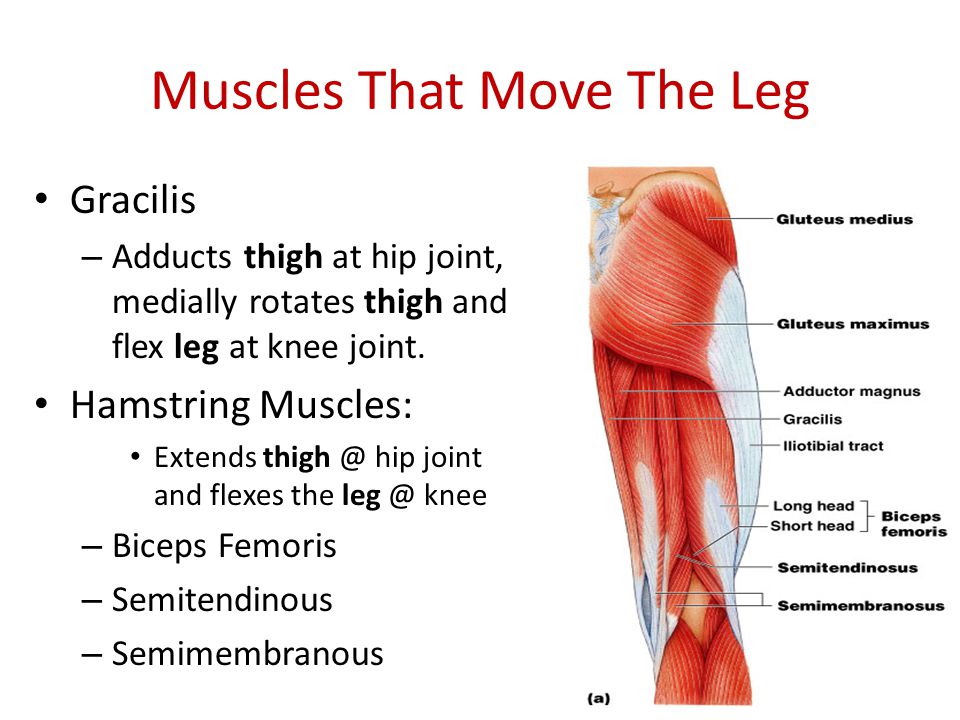 The adductor muscles pull the legs together.
The adductor muscles pull the legs together.
The hamstring and quadriceps muscle groups are particularly at risk for muscle strains because they cross both the hip and knee joints. They are also used for high-speed activities, such as track and field events (running, hurdles, long jump), football, basketball, and soccer. A tear in a thigh muscle is referred to as a thigh strain and depending on its severity it is classified as a first, second or third degree strain:
- First degree strain is damage to a few muscle fibres
- Second degree strain is damage to a more extensive number of muscle fibres
- Third degree strain is a complete rupture of the muscle itself
Thigh Muscle Strain Signs & Symptoms
There are some common symptoms of a muscle strain including:
- Popping or snapping sensation as the muscle tears.
- Sudden and severe pain.
- Injured area may be tender to the touch, with visible bruising if blood vessels are also broken.

Grade 1
With a grade one thigh strain the signs may not be present until after the activity is over. There may be a sensation of cramp or Thigh tightness and a slight feeling of pain when the muscles are stretched or contracted.
Grade 2
With a grade two thigh strain there is immediate pain which is more severe than the pain of a grade one injury and produces pain on walking. It is confirmed by pain on stretch and contraction of the muscle. A grade two Thigh strain is usually sore to touch.
Grade 3
A grade three thigh strain is a complete rupture of a muscle and is a serious injury. There is immediate burning or stabbing pain and the athlete is unable to walk without pain. Often there is a depression in the thigh at the location of the tear and a lump above the depression. After a few days with grade two and three injuries a large bruise will appear below the injury site caused by bleeding within the tissues.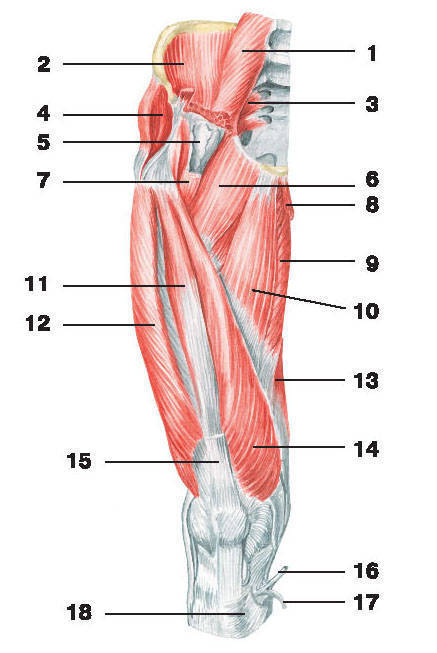
Treatment
Most muscle strains can be treated with the RICE protocol. RICE stands for Rest, Ice, Compression, and Elevation. This should help to limit bleeding and swelling in the tissues. After the early days have been spent resting more active rehabilitation can be started.
Rest will relieve the pressure from the joint and ease the pain slightly. Avoid activities that aggravate the problem.
Applying Ice to the affected area can help reduce inflammation and pain. Try applying ice for 10-15 minutes once or twice a day.
Compression prevents additional swelling, so lightly wrap the injured area in a soft bandage or ace wrap.
Elevation minimizes swelling. Raise your leg up higher than your heart.
Your doctor may recommend a non-steroidal anti-inflammatory medication, such as ibuprofen for pain relief.
Exercise
The muscle should be at full strength and pain-free before you return to sports.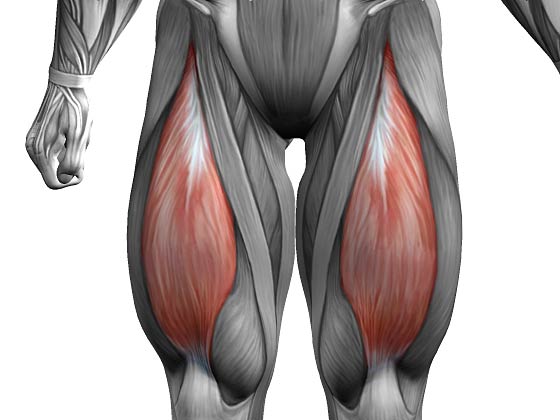 This will help prevent additional injury. As a general rule, grade one thigh strains should be rested from sporting activity for about 3 weeks, and grade two thigh strains for about 4 to 6 weeks. In the case of a complete rupture the thigh muscle will have to be repaired surgically and the rehabilitation afterwards will take about 3 months.
This will help prevent additional injury. As a general rule, grade one thigh strains should be rested from sporting activity for about 3 weeks, and grade two thigh strains for about 4 to 6 weeks. In the case of a complete rupture the thigh muscle will have to be repaired surgically and the rehabilitation afterwards will take about 3 months.
As the pain and swelling subside, physical therapy will help improve range of motion and strength. Gentle resistance exercises and thigh stretching are important, as they help to align the scar tissue that forms during the healing process and enhance the tensile strength of the thigh muscle.
As the thigh muscles get stronger, core strength and core stability exercises can improve muscle function across the trunk and pelvis and reduce the risk of Hamstring injury. Core strength exercises using a Swiss Ball and Resistance Bands are ideal for a quick return to functional activity.
Prevention
Risk Factors
Several factors can predispose you to muscle strains, including:
- Muscle tightness.

- Muscle imbalance.
- Poor conditioning.
- Muscle fatigue.
Precautions
You can take the following precautions to help prevent muscle strain:
- Condition your muscles with a regular program of exercises.
- Warm up before any exercise session or sports activity, including practice.
- Take time to cool down after exercise.
- Warm Pants (Compression Shorts) or a Thigh Support can help to retain muscle temperature and are very for the prevention of thigh muscle injuries.
- Practicing sport specific activities helps tune coordination and prepare mentally for competition
- Maintaining good muscle strength and flexibility may help prevent muscle strains.
- Carbohydrate and fluids need to be replenished during training and matches by taking Energy Gels and Energy Bars.
If you need immediate attention for any non-emergency problem like spraining your ankle, straining a muscle, or just getting bruised during the course of your normal day, then you don’t have to wait a few days to see a physician.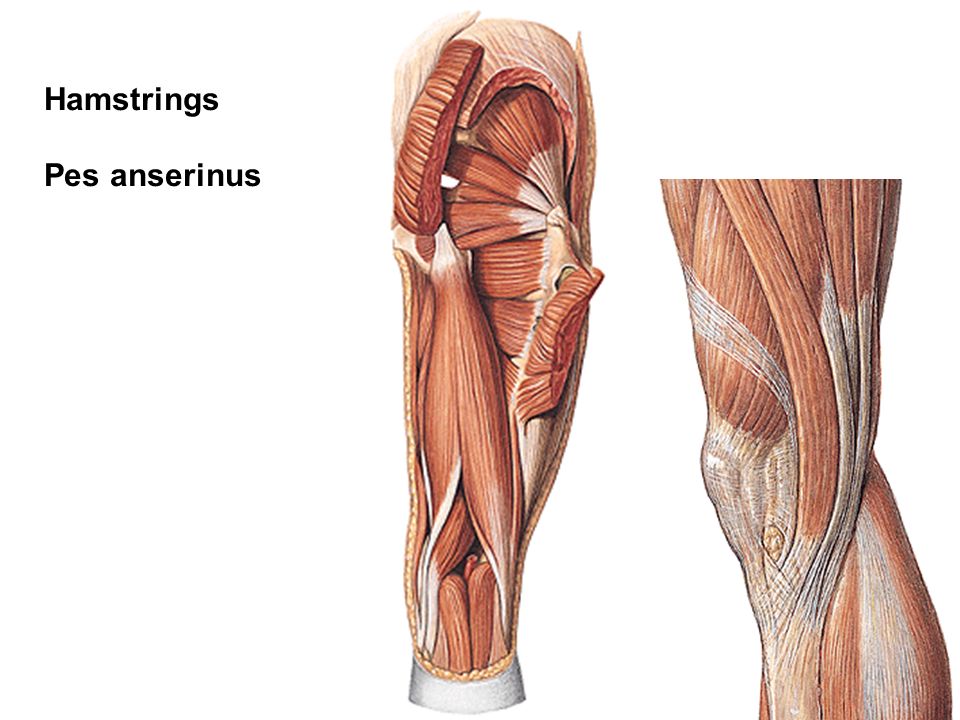 IBJI’s OrthoAccess is designed to provide assessment, treatment and follow-up care for most orthopedic injuries. For more information, please contact us today.
IBJI’s OrthoAccess is designed to provide assessment, treatment and follow-up care for most orthopedic injuries. For more information, please contact us today.
Anatomy, Common Injuries, and Exercises
The hamstrings are a group of muscles that cross the hip and knee joints and are responsible for walking, running, jumping, and many other physical activities. The hamstrings flex the knee joint and extend the thigh backward to propel movement.
Located at the backs of the legs, the hamstrings are the opposing muscles to the quadriceps. Because the hamstrings originate at the sitting bones, they are naturally stretched while sitting. However, long periods of sitting may affect how they function and lead to tightness.
Hamstring injuries are quite common. In fact, they are the most prevalent injury in sports. Learn how the hamstrings function and why strengthening and stretching exercises can help prevent injury from occurring (and reoccurring).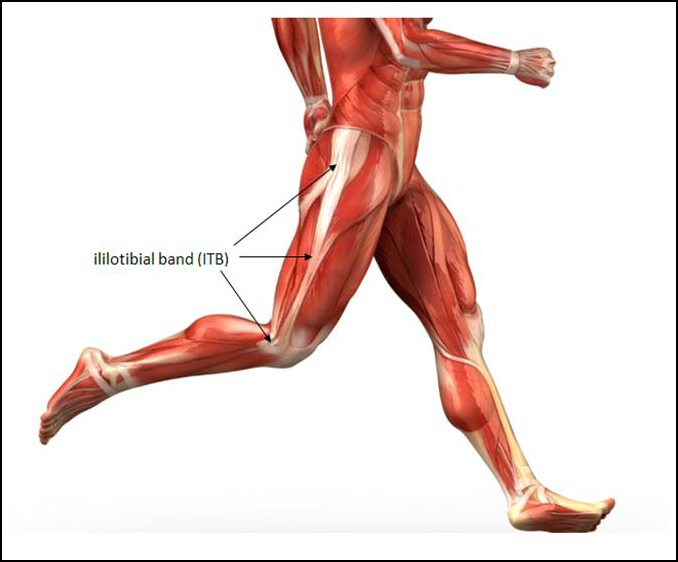
Anatomy of the Hamstrings
The tendons of the hamstring muscles attach to bone at the ischial tuberosity of the hip (more commonly known as the sitting bones). This region is located at one end of the linea aspera, a ridge along the femur (thigh) bone. The hamstring tendons also flank the space behind the knee.
There are three main muscles that comprise the hamstring muscle group. The biceps femoris is a big, long muscle located at the back of the thigh that includes both a long head and a short head. The semitendinosus is located at the posterior and medial (inner) part of the thigh and the semimembranosus is the most medial of the hamstring muscles. Here’s a closer look at the hamstring muscle group.
Biceps Femoris
The long head and short head of the biceps femoris are two muscles that work together to externally rotate the thigh at the hip and extend the leg backward. They are the main contributors to hip extension but they also flex and laterally rotate the knee at the joint./GettyImages-149678870-5702c33f5f9b581408a76e0b.jpg) The biceps femoris attaches to the main part of the lateral tibia (shin bone) and is innervated by the sciatic nerve.
The biceps femoris attaches to the main part of the lateral tibia (shin bone) and is innervated by the sciatic nerve.
- Long head biceps femoris: The most lateral hamstring, the long head or “superficial” biceps femoris inserts on the lateral side of the fibula (lower leg bone) and originates from the inner sides of the sitting bones.
- Short head biceps femoris: The short head of the biceps femoris originates in three places on the femur bone that are situated closer to your knee than your hip.
Some experts do not consider the short head of the biceps femoris as part of the hamstring muscle group, because it is the only muscle in the group that does not cross two joints.
Semitendinosus
Like the biceps femoris, the semitendinosus is a big, long hamstring muscle. It originates from the inside of the back of the thigh near the biceps femoris at the inner sides of the sitting bones. It also crosses the knee and connects to the inner side of the upper part of the shin bone.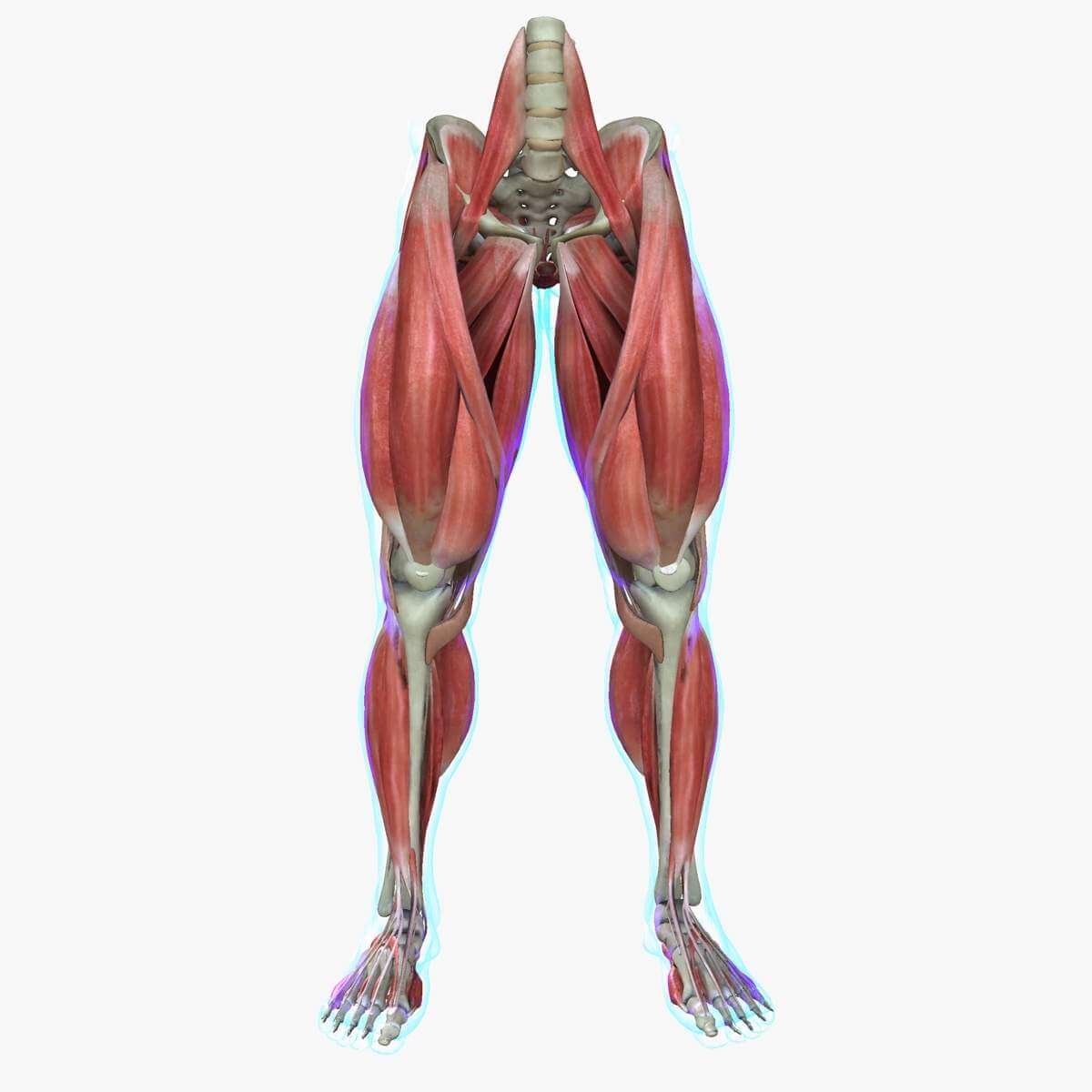 It also attaches to the fascia of the leg. The semitendinosus extends the thigh backward and allows for the medial rotation (i.e., turning the lower extremity inward) of the thigh and knee joint.
It also attaches to the fascia of the leg. The semitendinosus extends the thigh backward and allows for the medial rotation (i.e., turning the lower extremity inward) of the thigh and knee joint.
Semimembranosus
The most medial muscle, the semimembranosus inserts on the inner portion of the shin bone. Like the semitendinosus, the semimembranosus is a broad muscle, though it is more tucked away.
It originates at the sitting bones, similar to the other muscles in the hamstring group. However, it attaches higher up. It also connects to the inner portion of the upper tibia (knee joint). The semimembranosus extends the hip joint and flexes and also medially rotates the knee toward the midline.
Hamstring Injuries
Overuse injuries to the hamstrings are common, particularly in sports like soccer, football, basketball, and tennis, where running is combined with rapid starts and stops. The long head of the biceps femoris is particularly prone to injury in sports such as these, likely because it exerts the most force compared to the other muscles in the hamstring group.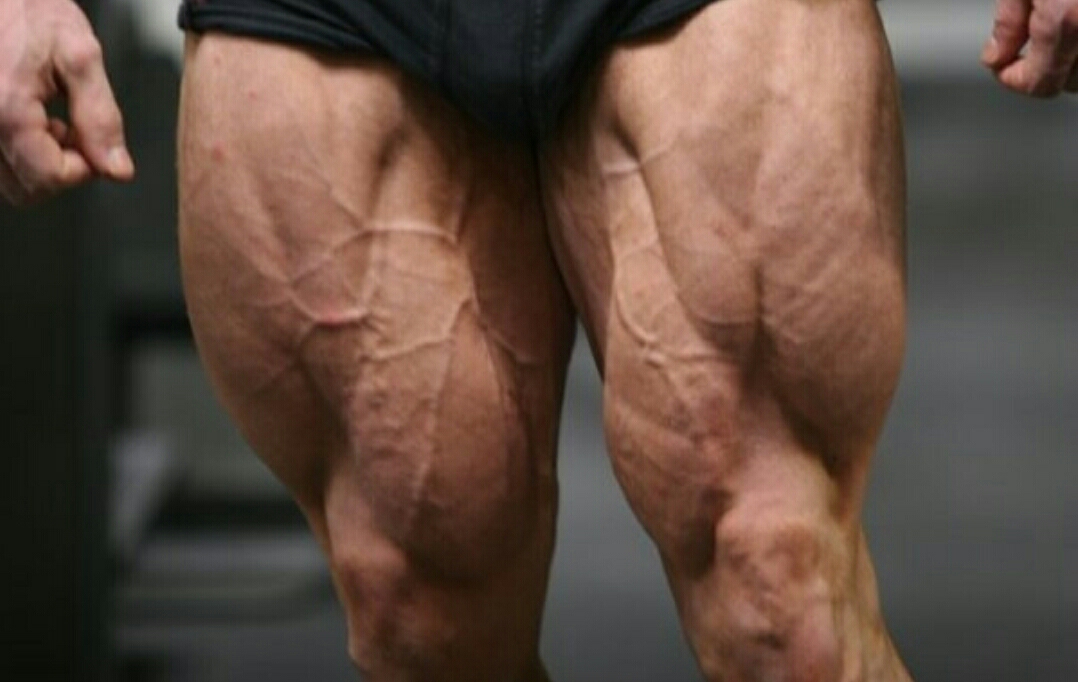
Hamstring sprains and tears are also relatively common. And they can become more serious when there is significant bruising behind the thigh. Repetitive stress injuries from running or walking are also a common cause of hamstring pain and injury.
Strains and Contusions
The onset of injury to the hamstring muscle group is often sudden and is usually identified as a strain (sprain or tear) or contusion (bruising). Strains range from mild to severe and include the following traits.
- Mild strains involve minimal damage to the muscle and heal quickly. They can be treated with rest and over-the-counter pain medication.
- Moderate strains cause a partial rupture of the muscle and result in a loss of function.
- Severe strains result in a total rupture of tissue and lead to short- or long-term functional disability.
Contusions are caused by an external force making contact with the hamstring muscles, such as with many contact sports.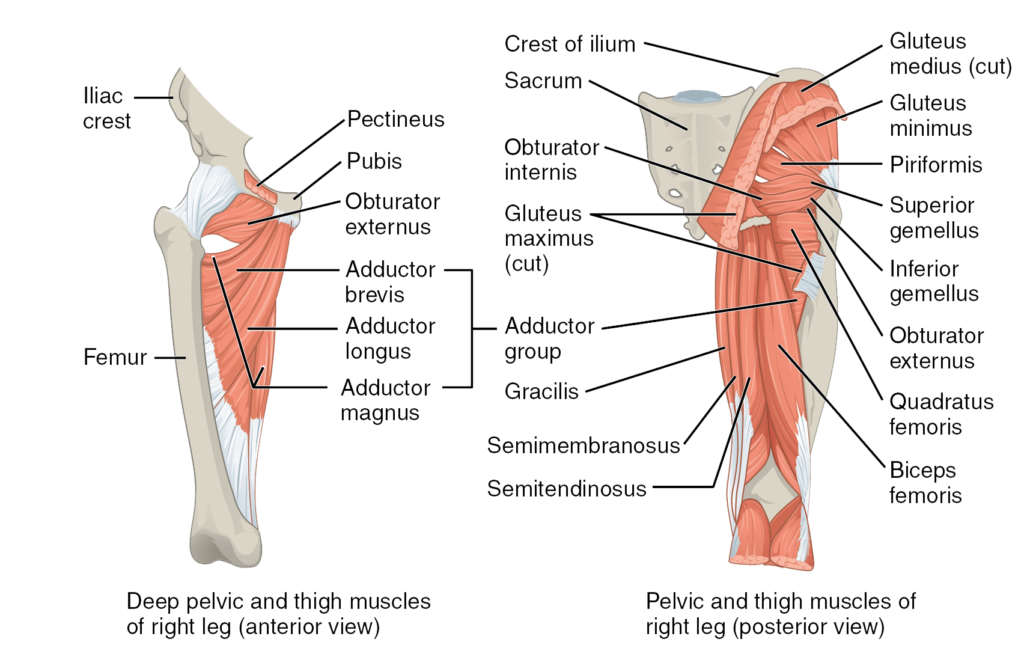 Symptoms of contusions include:
Symptoms of contusions include:
- Muscular pain
- Swelling
- Bruising and discoloration
- Limited range of motion
- Stiffness
If pain resulting from a hamstring injury does not resolve in a few days or is inhibiting your ability to walk normally and perform everyday activities, see your doctor for a diagnosis and treatment.
In addition, studies show that 12% to 33% of hamstring injuries are reoccurring. If you play a sport and sustain a hamstring injury, you will likely need to fully rehabilitate before returning to normal activity. This will allow the muscle group ample time to recover and repair, which can help prevent a relapse.
Strengthening Exercises
Walking, running, and climbing and descending stairs all help to build the functional fitness of the hamstring muscle group. Hamstring exercises can be beneficial for anyone, but they can be especially helpful for people who run or cycle, both of which target the quadriceps.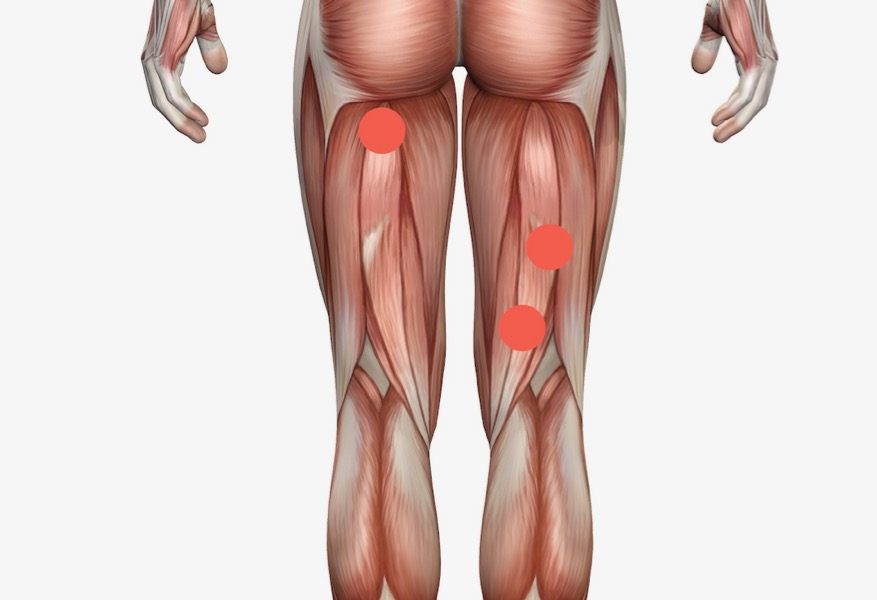 It’s important to balance the development of the quadriceps with cross-training that includes adequate strength and conditioning of the hamstrings.
It’s important to balance the development of the quadriceps with cross-training that includes adequate strength and conditioning of the hamstrings.
Various isolation and compound exercises for the hamstrings can also be employed in rehabilitation settings or in bodybuilding. Exercises that involve knee flexion and hip extension are commonly used to build the hamstring muscles. Here are a few fundamental moves to try.
- Basic bridges: This simple exercise isolates and strengthens the hamstrings and gluteal muscles. Press your feet into the floor and engage your glutes to fire your hamstrings and lift your hips.
- Single-leg bridges: Similar to basic bridges, single-leg bridges target the hamstrings and glutes with the added challenge of leg lifts to promote core stability. Maintain the lift of your hips and pelvis by using the strength of your glutes and hamstrings rather than your back muscles.
- Leg curls: Also known as hamstring curls, these exercises are commonly done with gym equipment to strengthen the hamstring muscles and calves.
 They can also be performed with an exercise ball by lying on your back and placing your heels on the ball, and then rolling the ball in toward you as you bend your knees and lift your hips.
They can also be performed with an exercise ball by lying on your back and placing your heels on the ball, and then rolling the ball in toward you as you bend your knees and lift your hips. - Squats: This classic move can be performed with or without weights to work the hamstrings, glutes, and quadriceps. Keep your back straight and head upright as you reach your seat back to lower into a squat.
- Walking lunges: This stability exercise strengthens the hamstrings, quadriceps, glutes, calves, and core muscles while testing your balance. Keep your torso tall and upright as you step forward and back.
Basic Stretches
Hamstring flexibility is important for runners and may help prevent injury and delayed onset muscle soreness (DOMS) after exercise. Tight hamstrings may limit your range of motion when you straighten your knee. You might also feel a cramp at the back of the knee.
Hamstring stretches can be incorporated into just about any regular stretching and flexibility routine.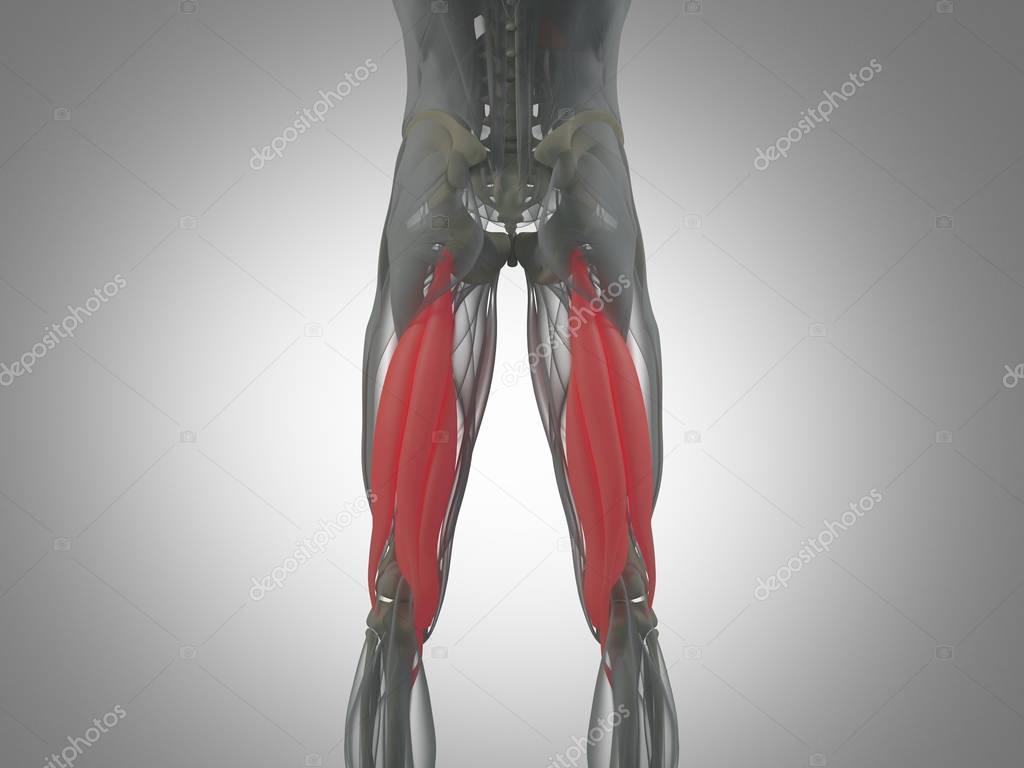 The following hamstring stretches can be performed daily to improve flexibility, promote recovery, and prevent injury.
The following hamstring stretches can be performed daily to improve flexibility, promote recovery, and prevent injury.
Seated Stretch
- Sit on an exercise mat with both legs stretched out in front of you and feel your sitting bones making contact with the floor.
- Bend one knee to slide the foot in toward the opposite knee, placing your foot flat on the floor.
- Hinge at your hips and reach your hands toward the toes of the straightened leg. If there is a lot of tightness, you can bend that knee slightly.
- Hold the stretch for 15–30 seconds.
- Switch sides.
Supine Stretch
- Lie on your back on an exercise mat with your knees bent and place your feet on the floor about hips-distance apart.
- Lift one leg toward the ceiling, maintaining a neutral spine.
- Reach behind the back of the thigh and gently tug the leg in closer. Optional: Allow the knee to bend slightly to increase the range of motion.

- Hold for 15–30 seconds.
- Lower the leg and then switch sides.
Standing Stretch
- Start standing tall and upright with your feet about hips-distance apart.
- Take a natural step forward with your heel and keep the toes lifted.
- Place your hands on your hips as you sit back slightly and hinge forward.
- Allow your spine to naturally round forward as you reach for the lifted toes.
- Let your knees soften as you reach your seat back a little more and drop your chin toward your chest.
- Hold for 15–30 seconds.
- Bring your hands back to your hips to stand back up and step the feet back together. Switch sides.
Butt and Thigh Exercises: Firmer Thighs & Backside
Shape Up Your Butt and Thighs
Ready to get firmer thighs and a better backside?
By Barbara Russi Sarnataro
WebMD Weight Loss Clinic – Feature
If you’re looking to have a better looking bottom half, keep reading.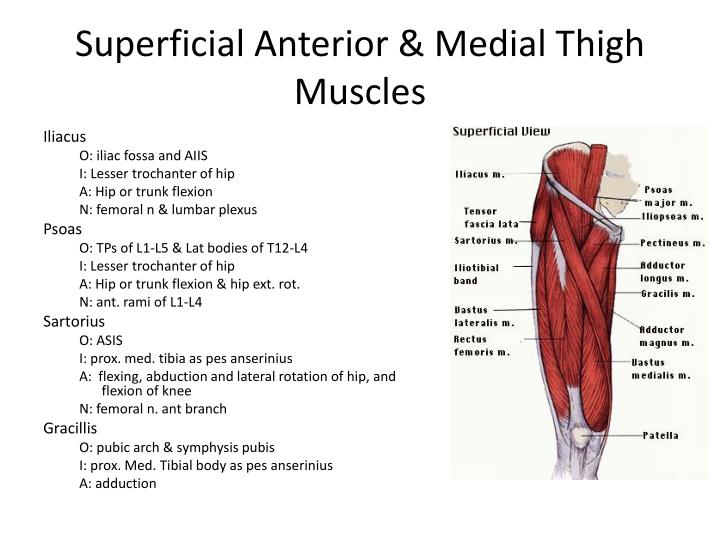 The WebMD Weight Loss Clinic can help you with everything from what and when to eat to exercise photographs with step-by-step instructions.
The WebMD Weight Loss Clinic can help you with everything from what and when to eat to exercise photographs with step-by-step instructions.
The trick to getting nicely sculpted thighs and glutes is specifically targeting these muscle groups — the quadriceps (front of the thighs), hamstrings (back of the thighs), and gluteals (butt).
Building these muscles will increase stamina in most everything you do, including climbing stairs, getting out of a chair, squatting to pick up a baby off the floor, or walking the grocery aisles.
Some of the largest in the body, the upper leg muscles, are made up of quadriceps, hamstrings, abductors (outer thighs), and adductors (inner thighs) and it is important that they be worked with some balance, says exercise physiologist and personal trainer Nicole Gunning.
“You want to develop these muscles in a balanced way for optimal function,” says Gunning. “Otherwise you end up with things like improper gait, problems with balance, and trouble with normal daily living activities. “
“
Weak, tight, or imbalanced muscles are going to manifest in more than just reduced performance. Over time, these imbalances cause bigger problems.
“Over-attention to any muscle group is going to cause a compromise in another,” says Gunning.
When one part of the leg is more developed than the other, it can pull the hips and pelvis out of alignment, which challenges stability and eventually leads to back, hip, knee, and ankle pain, she says. The next thing you know, people are treating back or knee pain, when what they really want to be doing is balancing muscle development.
Gunning sees many clients with tight hamstrings, for instance, runners.
“Using these muscles over and over on hills and different terrain,” she says, “and repetitively contracting the muscle and not stretching can reduce the range of motion.”
Stretching is a huge part of the equation, says Gunning.
“A lot of people that have injuries, I believe a big part is that they don’t make a conscious effort to stretch. They’ll do two minutes of stretching after 50 minutes of working out.”
That is wrong, says Gunning. Stretching should be incorporated into any weight training and cardiovascular program, just the way a healthful, nutritious diet should. You can’t expect to work out but eat Twinkies all day and look good. By the same token, you shouldn’t expect to prevent injury by constantly contracting a muscle group and never extending it.
Following are a few exercises for the thighs and gluteals. This is by no means an exhaustive list, just a few options to develop the muscles of the lower body. Gunning does warn however, that there is no such thing as spot reduction.
“It’s a combination of working the muscle and changing the diet,” she says. “Sometimes a person can lose weight and train properly and do everything right and some areas are harder to change.”
Gravity, connective tissue, age, and genetics all play into the shape of our butt and legs, she says. But don’t let that be a roadblock, either.
“You’re still going to tone muscles and feel better and look better.”
LEGS/BUTT:
Beginners should strive to complete one set of 10-15 and work toward completing two to three sets.
MUSCLE GROUP: FRONT OF THIGHS (QUADRICEPS)
Tip: Gunning says when performing each exercise, put your mind into the muscle(s) you’re working and complete a full range of motion with slow, controlled, and deliberate movement.
Dumbbell Lunge:
|
MUSCLE GROUP: BUTT (GLUTEALS), QUADRICEPS, AND HAMSTRINGS
Dumbbell Squats:
|
Bridge:
|
Variation: For more of a challenge, from the top of the bridge, lower the spine halfway down, then squeeze the butt to lift back up.
MUSCLE GROUP: OUTER THIGH
Lying Abduction:
|
MUSCLE GROUP: INNER THIGH
Lying Adduction:
|
90,000 Muscles of the back of the thigh | SLAVYOGA
Friends, hello everyone! In this publication, I analyzed the muscles of the back of the thigh, or, as they are also called, the flexor muscles of the lower leg, which, being affected by trigger points, can cause pain in the lower part of the buttock, back of the thigh, knee joint and even the lower leg. As usual, we will first talk about anatomy, function and trigger points, and in the second part of the article, we will analyze therapeutic exercises that can help yourself to remove pain at home and restore the health of muscles and fascia.
Who loves video content more –
WATCH THIS VIDEO
Who likes to read more – text with illustrations below.
Muscles of the back of the thigh: anatomy
The group of flexor muscles that make up the back of the thigh includes 3 muscles: semitendinosus and semimembranosus, which are located closer to the inner thigh and the biceps femoris, which consists of two heads (short and long) and is closer to the outer surface of the thigh.
Above, the semitendinosus muscle, lying above the semimembranosus, attaches to the tuberosity of the ischium, and below its tendon attaches to the tuberosity of the tibia, and part of the bundles is woven into the fascia of the leg. By the way, this tendon is easy to feel in the bent position of the leg at the knee joint and contracted muscles, closer to the inner thigh next to the knee.
The semimembranous muscle, lying under the semitendinosus, is attached at the top to the tuberosity of the ischium, and at the bottom to the posterior inner surface of the medial condyle of the tibia.
The long head of the biceps femoris at the top is attached to the tuberosity of the ischium. The short head, lying under the long head, is attached at the top to the lateral lip of the rough line of the femur. At the bottom, both heads of the biceps femoris are combined into a common tendon and attached to the posterolateral surface of the fibular head. This tendon can also be easily felt closer to the lateral surface of the lower leg near the knee joint by bending the leg at the knee and tensing the muscles.
Muscles of the back of the thigh: functions
All three muscles are involved in hip extension in the hip joint
and in knee flexion.
All three muscles with a fixed lower limb, together with the gluteus maximus muscle, extend the trunk in the hip joint.
Semitendinosus and semimembranosus muscle with bent knee rotate the lower leg inward.
The biceps femoris with bent knee rotates the lower leg outward.
All three muscles limit the flexion of the leg in the hip joint, which occurs under the influence of body weight during the phase of placing the foot during walking.
Trigger points of the muscles of the back of the thigh
Trigger points located in the semitendinosus, semimembranosus and biceps femoris cause extensive characteristic pain from the gluteal fold region, going down the back and back of the thigh, knee and lower leg.
Trigger points located in the semitendinosus and semimembranosus muscles reflect pain in the gluteal fold area, in the posterior-inner surface of the thigh and knee, in some cases going even lower to the lower leg area.
Trigger points, localized in both heads of the biceps femoris, cause pain that from below captures the area of the posterior and posterior external surfaces of the knee joint and the upper part of the lower leg, and from above extends to the posterior surface of the thigh to the area of the gluteal fold.
Myofascial pain syndrome caused by damage to the flexor muscles of the lower leg has been described, including in children. These muscles ranked fourth in the frequency of occurrence of trigger points in 85 children under study with myofascial trigger points.(Bates T, Grunwaldt E: Myofascial pain in childhood. J Pediatr 53: 198-209, 1958.)
Trigger points in the flexor muscles of the lower leg cause pain that increases while sitting and walking, which may be accompanied by lameness, and often disturb sleep.
The onset of pain or its prolonged existence can cause acute or regularly repeated overload, muscle injuries as a result of compression of the lower thigh, for example, by the high front edge of a chair seat. In addition to overloading, overstretching of these muscles can also lead to problems, for example, when hitting the ball in football or when mastering the longitudinal split.
In a sitting position, pain can occur in the buttocks, upper hamstrings, and back of the knee. Pain can also occur or worsen when getting out of a chair, especially after prolonged cross-legged sitting.
An effective way to eliminate such pain is to use a special footrest, which not only prevents prolonged shortening of the calf and soleus muscles of the lower leg, but also raises the hips, which is especially important for children and stunted people when, while sitting on a chair or chair, the feet do not reach the floor.When using such a support, it is important to observe the angle of flexion in the knee and ankle joints. Do not put your foot too close to the chair and rest your heels on the floor.
It is necessary to put the foot in a neutral position on a support, the angle of flexion in the knee joint must be greater than 90 degrees, i.e. stupid.
The legs should be in a position in which you can freely move your hand between the thigh and the front edge of the seat, which indicates that there is no compression of the muscles of the back of the thigh.
A particular urgent problem concerning children is rigid school chairs, which have standard sizes and are not adapted to different heights of schoolchildren.
As I said earlier, in children, the flexor muscles of the lower leg are in fourth place in terms of the frequency of myofascial trigger points. Parents, pay close attention to how your children are sitting at home and at school, this is very important for maintaining their health.
Shortening of the muscles of the back of the thigh leads to an overload of the quadriceps muscle of the thigh, as a result of which trigger points can also form in it, causing a characteristic pain picture.I have already recorded a video about the quadriceps muscle of the thigh, you can watch it below.
Recommend for viewing
Since the muscles of the posterior surface of the thigh are part of the superficial posterior line described by Thomas Myers and form a single functional chain, which also includes the plantar fascia and the muscles of the foot, the gastrocnemius muscle, the sacroiliac ligament, the sacro-lumbar fascia and the muscle that straightens the spine, the suboccipital group muscles, supracranial aponeurosis and fascia of the skull, then their persistent shortening will inevitably provoke problems and pain symptoms in the foot, lower leg, muscles along the spine, neck and even the head.
The flexor muscles of the lower leg affected by the trigger points lead to a significant limitation of mobility when lifting the straightened leg. Muscle shortening is diagnosed if the leg straightened at the knee joint cannot be lifted up to 80 degrees above the horizontal line.
In people with hardened and shortened muscles of the back of the thigh, the pelvic bone may be displaced backward, which leads to a smoothing of the lumbar lordosis, as well as excessive tilt of the head forward, which in turn will lead to damage to the quadratus lumbar muscle, paravertebral muscles, neck muscles and shoulder girdle with the possible development of headache, cerebrovascular accident, damage to the temporomandibular joint.I covered this topic in detail in a video on correct posture, you can check it out below.
Recommend to watch
Treatment of the muscles of the back of the thigh
In case of damage to the muscles of the back of the thigh with trigger points at home, you can help yourself by mechanical action on the problem area, followed by stretching of the muscles and the surrounding fascial membranes.
For mechanical action, take a large massage roll and roll it on the back of the thigh for a few minutes (see the video at the beginning of the post).
Of course, it is better to work out both the foot and the lower leg, and all surfaces of the thigh, and the gluteal region, and the lower back with the back, and neck at a time, this will have a more pronounced healing effect, but since the publication is devoted to the muscles of the back of the thigh, then in it we will analyze the effect only on the areas of trigger points in the muscles of the back of the thigh.
After rolling on a large roll, take a massage ball with a diameter of 12 cm and apply a deeper and more targeted effect on the areas of greatest compaction and soreness in the muscles.Having found such an area, press firmly and continuously on it for 30-60 seconds. Pay special attention to the area of muscle attachment to the ischial tuberosity.
A small massage ball with a diameter of 8 cm can be even more intense, but near a wall or on the floor, or it sinks into the muscles, especially if you have voluminous hips and does not apply the necessary pressure. For more efficiency and convenience of this exercise, use the edge of a tabletop or wooden chair and roll the back of the thigh with the knee bent and the lower leg hanging quietly.
After mechanical action on the muscles of the back of the thigh, they need to be gently stretched. It is important to keep in mind that without preliminary mechanical action on the trigger points of the muscles of the back of the thigh, they stretch poorly. Therefore, if before any physical activity you perform only stretching, and at once intense, then this can lead to problems with muscles and ligaments, as well as to increased pain symptoms.
Since the main function of all three muscles is flexion of the lower leg in the knee joint and extension of the hip in the hip joint or posterior tilt of the pelvis with a fixed lower limb, then these muscles will be stretched in any position in which the leg is extended in the knee joint and the hip is flexed in the hip, or anterior tilt of the pelvis with a fixed leg.
The simplest exercise for stretching the muscles of the back of the thigh is supine position with a straight leg raised. You can work only with your hands, grabbing the thigh or, if available, the lower leg, direct the toe towards you and pull the leg towards the body. You can also use a belt or yoga loop, the end of which is located on the foot, and the other end is gripped by your hands.
The same exercise can be done while standing, with your foot on a high support in front of you and gently tilting the pelvis and body forward.
Strengthen the degree of traction by pulling on the sock.
You can also stretch the leg flexor muscles while sitting. To do this, first pull up the gluteus maximus muscles, thereby exposing the ischial tubercles and making a slight forward tilt of the pelvis. Then, keeping your back straight, grab your shins or feet with your hands and feel in this position the tension on the back of the thigh and lower leg.
Strengthening the degree of traction is possible with the coordinated movement of the eyes with breathing.To do this, while inhaling, look up, slightly straightening the cervical spine, and with a slow and smooth exhalation, go into an even deeper tilt, slightly lowering your head.
In the practice of hatha yoga, a number of other exercises are used in which you can stretch these muscles. These are uttanasana with the body tilted forward to straight legs and padahastasana, in which the degree of extension becomes even greater with the help of the lever of the arms, and longitudinal split, where the back of the front leg and the front of the hip of the back leg are intensively stretched, as well as a number of other exercises.
An important point in the successful treatment of pain syndrome emanating from trigger points located in the flexor muscles of the lower leg is to avoid muscle overloads, which are observed, for example, when crawling, where the legs are constantly working and the hip is extended in the hip joint. Any running loads. You should also exclude activities that keep the muscles in a shortened state for a long time without stretching, for example, when cycling in a low sitting position, when the legs are not fully extended at the knees.
Friends, I hope this video was useful to you. The massage tools that I use in my work can be found here.
Sergei Chernov, doctor, yoga master tried for you. Good luck and see you in new publications!
I recommend to read
Go to other interesting articles
90,000 Human thigh muscles anatomy: anterior, posterior, lateral, medial groups
The body is like a puzzle, in which every detail is important for the completeness of the picture.In this article, we will take a closer look at the anatomy of the anterior and posterior muscle groups, as well as the inner and outer parts of the human thigh.
Fabric channels
The femoral triangle is what is placed in the upper region of the limb. It is formed by the adjacent muscles and ligaments. It contains nerves and blood vessels. The connective tissue membrane consists of two plates, between which a channel of the same name is formed, consisting of a pair of holes and three walls.
In this place, catheterization is performed, finger pressing – to stop bleeding.
The thigh muscles are one of the strongest developed in the human body. They hold the torso in an upright position, control the hip, knee joints, are used during the period of various activities, and even at rest. Their correct functioning is extremely important, and any person should know the principle of operation.
For ease of understanding, they are divided into 3 sections. We will analyze each of the points in more detail, and also consider the images.
Anterior femoral muscles
This group includes mainly the flexor muscles.
Quadruple
Many people know the synonymous name – quadriceps. From the name it is clear that it has 4 “heads”, each of which is considered as an independent link.
Lateral wide
The largest in its section, covers a large anterolateral surface.Goes from the greater trochanter to the patella. Gives a nice roundness to the outer area. Promotes straightening. Most often used when we do squats.
Medial broad
Flattened, thick-fiber. It starts from a rough line and ends with a tendon. The beams are directed along an obliquely descending line from the inside to the front. Performs lunges, jumps, helps to squat, actively works with knee extension.
Direct
The longest presented.Consists of two heads. In the upper part it connects to the pelvic bone, goes down to the knee joint. Takes part in the formation of the circumference of the limb. Works in jumping, pulling to the body. Thanks to her, we can keep our balance.
Intermediate wide
The thinnest, weakest among the rest. Serves as a division of the muscles of the thigh of the lateral group and the medial surface. Lies from the intertrochanteric line going downward. Promotes straightening.
Tailor
The narrowest, longest muscle.It originates from the ilium obliquely. Attaches to the surface of the lower leg. Bends the legs, pulls, turns and presses them to the stomach.
The anterior muscle group plays an extremely important role. It is not so easy to set in motion the most complex bone apparatus. It is a multilevel system that requires coordinated work.
Musculature of the back
Most of the muscles are located here – the flexors.
Double-headed
Thanks to her, we are able to rotate, maintain balance.Presented by two heads:
The first – comes from the ischial tubercle, the second – originates from the lateral zone of the rough line. They are attached to the head of the fibula, located closer to the lateral edge.
Semitendinous
Located in the medial part. It begins in the ischial tuberosity, passes near the knee, attaches to the tuberosity. In the center, it is often interrupted by an oblique tendon bridge. Performs similar actions to the two-headed.
Semi-membranous
The longest and flattest in its class. The initial end is connected to the pelvis, bends around the epicondyle.
It is interesting that it is the muscles of the back surface that are deprived of the proper load. A sedentary lifestyle is inherent in modern people. This leads to less use of them, which leads to an imbalance in development and an increased risk of various injuries, especially the knee. And they are extremely unpleasant, as they restrict movement and take an extremely long time to heal.Re-injury is also possible, which will lead to a longer recovery period.
Inner thigh, muscle names
It is considered the most problematic. The skin here is somewhat thinner, which affects the appearance, especially in the beautiful half of humanity. In addition, sprains and tears often occur here.
Another name is leading. Simply put, the main function is to bring the legs together.Strengthening them is very important, training programs are based on this very action. Let’s consider each in more detail.
Comb
The structure is similar to a quadrangle. Attached to the line of the same name of the femoral region. Located diagonally. Works when running, walking and squatting.
Slim
It is a long bundle located in the pubic area. Crosses the knee and attaches to the tibia. Extends and turns the lower leg.Works in conjunction with other adductors (from the Latin adductor – leading).
Short driving
Flat, small in size, extending from the pubis downward, to a rough line. Flexes and rotates the limb outward. Often injured during sports. It is necessary to warm up so as not to provoke tears and stretching. Healing takes a long time. Pain syndrome is localized in the groin area.
Large leading
The fibers are deep.Pass from the pubic articulation. Fills the inner space of the femoral area. One of the most difficult to palpate. Its main task is to stabilize the pelvis and align it relative to the lower extremities. This is due to the peculiarities of the fastening. Weakness and underdevelopment leads to hypertonicity and overstrain of neighboring areas.
Long leading
It is flattened and looks like a triangle. Located on the anteromedial side, expands downward.Most convenient for palpation.
Interestingly, adductors are called “guardians of virginity” or “muscles of morality.” Because their increased work and overstrain is associated with dysregulation of sexual activity. This function of “squeezing the legs” leads to the suppression of sexual arousal. It is especially developed in the female sex, as it is a natural defense mechanism.
Outer part
This is the smallest category.But it plays a very important role and makes up the muscles of the thigh of the lateral group.
Fascia tensioner
Relatively small, flat and slightly elongated. It starts from the pelvic region, goes vertically downward and passes into the iliotibial tract.
Participates in flexion, abduction and rotation (rotation). It is actively used when you need to set a stop. Helps in maintaining knee stability. The defeat leads to the onset of pain in the deep parts, which are difficult to differentiate.
Pelvis structure
It is represented by a fairly abundant and varied number of elements that perform many different actions. The muscles of the anterior group of the human thigh work together with the pelvic muscles, their structure and functions:
- Tube:
Iliopsoas. Divided into a couple of components. Plays a significant role in the performance of weightlifting exercises, maintains an upright body position, and also works when running, walking.It is an element of the abdominal press. It is one of the most powerful flexors around.
Pear-shaped. Controls rotation during movement, holds the head of the femur in the acetabulum. The shape and size may vary from individual to individual. It passes through the sciatic foramen, but does not completely fill it, leaving small gaps for blood vessels and nerves. This anatomical structure leads to the possibility of myofascial syndrome, we will talk about it a little later.
Internal locking. Flattened, fan-shaped bundles forming the channel of the same name. Rotates the limb.
- Outer layer:
Large, medium, small gluteus. They are located under each other. Participate in the abduction.
External locking. Has the shape of an irregular triangle.It is attached next to the muscle of the same name and performs similar functions.
Problems of the thigh muscles
Spasms, pain, discomfort are not uncommon for most of us. Many are faced with this or that problem. There may be one symptom, but there are many reasons. This condition occurs due to injuries, insufficient warm-up and overload. It is also important to take sports seriously. Be sure to study the relevant literature or consult trained trainers.The muscles of the anterior and posterior inner thighs, their anatomy and functions are very diverse, as are the problems with them.
DOMS or delayed muscle pain syndrome
Quite common among athletes. Unpleasant sensations arise due to increased physical activity. It usually appears after 8-12 hours. Disturbing at rest and when using overstrained muscles. Another striking sign is a decrease in stamina.
Why does it happen and how dangerous is this condition
For a long time, the pathology was associated with the irritating effect of lactic acid.Anabolic loads promote glucose oxidation and the active release of metabolic products. In trained people, this process is practically not manifested.
However, recent research has led to a new theory that is considered the most reliable. According to her, the cause is a change in the structure of the muscles and the occurrence of inflammation as a result. Muscle fibers are composed of myofibrils. These elements provide the strength and speed of the contraction. It is their deformation that occurs.
At the initial stage of playing sports, such a reaction is understandable and normal. In other cases, overexertion does not benefit the body. To prevent this, you need to thoroughly warm up, objectively assess your training. Conventional anti-inflammatory drugs can help relieve symptoms.
It is important to correctly differentiate this condition.
Myositis
This is inflammation of the muscle tissue. The main symptom is severe pain and weakness, there may be such concomitant manifestations: redness of the skin, swelling, increased temperature of the whole body.This happens due to: various injuries, hypothermia, vascular disorders or defects of the spine.
If such symptoms are found, you should consult a specialist. Only he will be able to make the correct diagnosis and prescribe treatment. As a possible surgical intervention.
Discontinuities
The thigh muscles are most susceptible to this action. It is characterized by limited mobility, sharp pain immediately after a blow or excessive exertion.An extremely dangerous condition. Some of its types require surgical intervention.
Stretching
Improper training or falls often provoke deformation. Unpleasant sensations can be accompanied by hematomas or even a “click”, this indicates a strong injury.
First of all, you need to apply a compress for 15–20 minutes. Ice or a cloth soaked in cold water is suitable for this. Then make a fixation bandage, using an elastic bandage or compression stockings.This will reduce the swelling. Try to restrict movement. If it does not get better within 24 hours, contact the clinic.
Hypotrophy
This is a condition that occurs as a result of metabolic disorders. The muscles are literally starving. Quite a dangerous disease that can lead to disability.
The main reason is inadequate intake of nutrients. This is due to: burns, hypothermia, intoxication, prolonged shift, and can also be a congenital pathology.Symptoms are as follows: increased pain, weakness, inability to perform the usual action, loss of body weight. Which leads to discomfort. Complex measures are used to solve the problem. Eliminate the primary factor, stimulate trophism, normalize metabolic processes.
At the “I Want to Walk” prosthetics center, we offer rehabilitation and adaptation to children with musculoskeletal disorders, give them the opportunity to join a full and vibrant life in society, show their abilities and talents, and master everyday and professional skills.
Piriformis syndrome
This is a neurological pathological manifestation characterized by a pulling action in the area of the buttocks and lower extremities. This can also lead to numbness, burning, and increased tension in the knee area.
Occurs due to compression of the sciatic nerve. This can be provoked by: hypothermia, physical activity, an incorrectly delivered injection, a defect in the spine or hip joint, muscle strain.
It is extremely difficult to independently determine the correct diagnosis. Better to leave it to a qualified technician. He will palpate, reveal painful foci and flattening. In the absence of a serious pathology, a few days of rest will be enough, in some cases, drug treatment, exercise therapy or massage are prescribed. Learn more about how to get rid of a spasm here.
Syndrome of the iliopsoas muscle
Disease of a tonic nature, the cause is injury to the fiber or adjacent places.However, this effect can affect innervation. Which leads to loss of sensation and motor function.
The clinical picture is very striking: involuntary contractions, weakness on the affected side, especially in the hip girdle. In this case, vigorous activity is impossible.
The pain can be localized in different places. In the intestines, legs, lower back, while in the supine position, it completely disappears.
It is treated with specially designed exercises that should only be performed as directed.They relieve tension, improve the general condition of the patient, promote relaxation, restore tone and blood circulation. And it is also possible to use drug therapy.
Conclusion
Our body is arranged in an amazing way. Human anatomy is mesmerizing, striking in its thoughtfulness in the smallest detail. Understanding it is most essential for athletes. This allows you to create an effective and safe training plan. Gives an understanding of how to do it correctly, indicates the importance of warm-up, moderate strength loads, so that the exercises do not harm.For ordinary people, this helps to differentiate between symptoms and the occurrence of discomfort. It is important to know the name of the anterior, posterior and internal thigh muscles, and everyone needs to take care of their health. You should not start negative manifestations, delay the visit to the hospital. Early diagnosis can prevent serious complications.
Used literature
Vasiliev PA – Atlas of Human Muscles.
Boris AI – “Anatomical Atlas.Fundamentals of the structure and physiology of man. ”
Exercises for firm and strong back of the thigh
The back of the thigh is a part of the muscles that is often overlooked. Typically, training focuses on quads and calves, but hamstrings seem to be less important . However, it should be remembered that neglect of any muscle has aesthetic and health effects that you can avoid by exercising well.[1] [2]
Hamstrings
The hamstrings intersect the hip and knee joints and they are composed of three separate muscles – biceps femoris, polymembranous and semitendinous . [12]
1. Biceps femoris – biceps femoris – is a muscle of the inner thigh, which starts in the thigh area and ends in knee .The biceps femoris provides the ability to bend the leg at the knee joint , turn outward, unbend it at the hip joint
2. Semimembranosus – semimembranosus – is the largest muscle among the hamstrings , starting from the ischial tuberosity. Heading downward, it passes into a flat tendon, which then narrows. It allows leg flexion and hip extension relative to the hip. In addition, it allows medial rotation of the hip with respect to the hip and medial rotation of the leg with respect to the knee.
3. Semitendinosus is the longest hamstring muscle located between the semimembranosus and femoral biceps. It occurs in the ischial tuberosity of the ischial bone. It allows flexion of leg and extension of the hip towards the hip, n allows medial rotation of the hip relative to the thigh and medial rotation of the leg relative to the knee. [12]
Best hamstring exercises
Admit it, do you train your hamstrings on leg day? The reason you shouldn’t forget about these muscles is because isn’t just about the symmetry and appearance of your body.Weak hamstring is one of the most common causes of athlete injuries that occur in both men and women. In this article, we will introduce you 10 exercises with which you will get a strong and beautiful back of the thigh. [1]
1. Romanian dead draft
Deadlift is one of the most effective exercises for strengthening the muscles in the back of the thigh. It differs from the classic deadlift in that the Romanian deadlift is performed with straight legs.How to do the exercise? Grasp a barbell approximately at shoulder width , , with shoulders pointing down . Bend your knees slightly and bend over as if you would like to place the barbell on the floor. Keep your back straight and be careful not to bend your knees too much or you will not be doing this exercise correctly. When you bend over, you should feel tension over your knees , which is the back of your thigh. Then return to the starting position by twisting your pelvis up and squeezing your buttocks . [2]
2. Deadlift sumo
The sumo deadlift is another deadlift option designed to strengthen the muscles in the back of the thigh. In a sumo-style deadlift, the legs are wider than the shoulders of (in some cases they practically rest against the pancakes), we hold the bar a little narrower than shoulder-width apart and carry out lifting due to the efforts of the quadriceps , adductors and buttocks. [3]
3. Leg Press
Sit on with your feet on the platform approximately shoulder-width apart.Release the safety arm and use your thigh muscles to push off the weight while keeping your knees in full extension. Never fully straighten your knees to avoid injury. After inhaling, slowly return to the starting position so that your knees and hips are at a 90 degree angle. [4]
4. Seated Leg Curl
Set the desired weight and sit on the machine. Place your ankles under the bottom roller and press against it.Begin to bend your knees, bringing the lower leg muscles to the hamstrings, pulling your legs under you , linger for 1 second at the end point. Then inhale and return to the starting position. [5]
5. Lying Leg Curl
Select a suitable weight, lie on your stomach and grip the handles of . Place feet under bolster so that they touch it a few centimeters below your calf. While exhaling, lift roller and hold it in the end position for 1 second. Exhale and slowly return to the starting position. Make sure you are not moving your hips when lifting the roller. [6]
6. Exercise “Good morning”
The main benefit of this exercise is that you don’t need machines, just the barbell. Start in a standing position with a barbell on your shoulders , keeping your back straight at all times. Bend your knees slightly, stretch your glutes and bend forward 90 degrees.Then inhale and return back to the starting position. In addition to the hamstrings in this exercise, you will also strengthen the gluteus and back. [7]
7. Hyperextension
Hyperextension is an excellent exercise for hamstrings and lower back and glutes . Position yourself comfortably on the hyperextension machine, lean your heels firmly against the platform at the bottom of the machine.Cross your arms over your chest or behind your head. Slowly lower yourself down until you feel a stretch in the muscles of the lower back and hamstrings, while inhaling. Without delay at the bottom point , straightening to the level of the starting position, exhaling . Then return to the starting position. Throughout the exercise, keep your head in line with your body, keep your back straight. [7]
8. Exercise Glute-ham Raise
This exercise resembles hyperextension .You can do it on a dedicated GHR bench, or with the help of partner . If this machine is in your gym, place your feet snugly between the bolsters, place your knees directly on the stand or slightly behind them. Throughout the exercise, hold your lower back and exhale with a downward movement of . Then rise to an upright position with your knees at a 90 degree angle. [2]
If you are unable to use this machine, sit on your knees and have a partner hold your ankles .As with the machine, exhale as you descend, and then lift up using the back of the thigh and buttocks. [2]
9. Hip Press
For this exercise you will need a barbell with a weight of . Lie on the ground and bend your knees. Place the barbell on your hips and lift your buttocks up. Hold this position and then lower yourself down. As you lift your hips, you will probably feel more pressure on the sciatic muscles than on the back of the thigh, but both muscles will be used equally .[2]
10. Swings in the crossover
Attach the adapter to the ankle and lower block. Stand one step away from a machine that you can hold with your hands. Swing your leg back so that the knees of both legs are always slightly bent. Then repeat exercise with the other leg . [2]
We believe you found in our article new hamstring exercises that will become part of your leg workout.If you want your friends to know about this article, be sure to support us by reposting .
How to pump up the back of the thigh
Why pump up the back of your thigh? Nobody sees it, nobody asks to show it, so why waste so much time and effort? Read the answer in this article
Do you doubt why and, most importantly, how to pump up the back of the thigh for an athlete? To get the answer to the first question, look at a professional bodybuilder.What do you see? That’s right, balance.
This term is increasingly heard in the bodybuilding world. Those who have balance have a chance to become champions, and those who do not have it are forced to suffer defeat. Balance is not only about the ratio of aesthetics and proportions to a competitive form, it plays a key role in practical functionality both in and out of the gym. Some antagonist muscles are critical to the development of strength, muscle mass and performance, so it is important for any athlete to pay attention to the balance between training volume and intensity.
Have you pumped your quads? You are well done! But now it’s time for their antagonists – the hamstrings. After all, the goal of any bodybuilder is to pump up the back of your hips so that they look spectacular from different angles of the stage, this is especially important for the back and side positions. These muscles are quite difficult to build, but if you do it, you will become a serious competitor. So let’s take a closer look at the structure of these muscles, break down the exercises for the back of the thigh and start training!
Ready to train? Here’s a basic video program for you.You will find various programs and variations later in the article.
Back of the thigh: Anatomical Information
Knowledge of anatomy will help you to properly pump up the back of the thigh. By being aware of how certain muscles work, you can concentrate on them during exercise, visualize their growth and desired size!
The back of the thigh consists of three large muscles:
- Biceps or biceps femoris (located along the outside)
- semitendinosus muscle (center)
- and semimembranosus muscle (on the inner surface)
All of them extend from the gluteus maximus muscle along the femur and are attached to the tibia.The functions of these muscles are flexion of the knee (as a result of which the heels can reach the buttocks), extension of the hip joint, and flexion of the lower leg. The muscles in the back of the thigh are involved in many movements: for example, the hamstrings play a vital role in the work of the quadriceps in squats, leg presses, and lunges.
Balance is not only a visual condition for the competitive form of a bodybuilder, but also a guarantee of the development of the entire lower body. If it’s not enough to pump the back of the thigh, the quads won’t be able to reach their full potential.
Exercises for the back of the thigh
Now that you are familiar with the anatomy and function of the hamstrings, let’s move on to work exercises that will pump the back of your thighs to outstanding dimensions. The proposed exercises and training programs are aimed at obtaining maximum results. To avoid injury, follow the technique, and do not take excessive weight.
Machine Leg Curl and Seated Machine Leg Curl
As one of the most popular exercises for trainees, machine leg curls are extremely effective in isolating the hamstrings.
How to swing the back of the thigh in a seated leg curl exercise? Bend your legs until you feel a strong tension in the back of your thighs. Try not to break the correct technique for performing the exercise. It is better to set a lower weight, but work at full amplitude. Adjust the weight so that the last 2-3 reps are the heaviest.
When performing an isolated movement, such as flexing each leg separately, try to concentrate on the work of the back of the thigh throughout the range of motion.Make every effort to complete the exercise and do not take long breaks between sets. While one leg is working, the other is resting, so there is no need to rest after each set – just a few seconds is enough. Your hips will thank you!
Leg Curl
Like the previous options, leg curl makes it possible to work each leg separately in isolation. With each repetition, the load on the muscles is stronger and stronger.
When the back of the thigh is overworked, try to avoid twisting the lower body.Not only will this not be beneficial, but it will also increase the risk of injury to the lower back / lumbar spine.
When doing a one-way movement such as a leg curl, do your best and do not take long breaks. While one leg is working, the other is resting, so there is no need to rest after each set – just a few seconds is enough. Your hips will thank you!
All variations of the deadlift for the development of the back of the thighs
Many people lose the difference between the Romanian deadlift (PCT) and the straight-legged deadlift (STPN).First, the PCT is performed with the knees slightly bent and the weight is pulled straight down. This exercise is aimed at pumping the back of the thigh and gluteal muscles. STPN is carried out on straight legs (sometimes the knees are blocked) and with a slightly arched lower back. This movement works on the hamstrings and lower back. Both exercises develop the hamstrings. Unlike leg curls in the simulator, PCT and STPN are more focused on the gluteal muscles and the area under the buttocks.
So how do you pump up the back of your thigh? What to choose: Romanian deadlift or straight-legged deadlift? For a beginner, the Romanian deadlift is preferable, and advanced athletes can perform STPN every 3-4 workouts in order to affect the muscles a little differently.You will have to use a lighter weight, but the strong stretch will quickly make up for this oversight.
A good alternative would be to work with dumbbells instead of a barbell. Dumbbells allow you to adjust the technique, and are just comfortable in gyms where there are a lot of people and the barbell is busy. Try both options and see what works for you.
Lifting the buttocks for pumping the hips
This good old exercise has been gaining popularity lately, and, I must admit, not without reason.This movement requires strong hips! Unfortunately, few trainers know the correct technique, which makes it difficult to properly pump the back of the thighs.
This exercise is quite difficult, so you will only be able to do a few reps at first. To make your job a little easier, use a small bar. Place it perpendicular to the floor and lean on it as you go up. Once you become comfortable with the technique and become stronger, you can do without this crutch. Another way to help beginners learn the correct hamstring pumping technique is to work on the bench at an angle for hyperextension (45 degrees)
Leg Press
After you have worked your muscles with various isolated exercises, do the leg press exercise to help build up and bulge the back of your thighs.Be sure to place your feet high so that you can push the weight with your heels, while keeping your lower back and pelvis firmly pressed against the bench. At the bottom of the movement, you should feel a stretch on the back of your thigh.
To act on different zones, place your feet narrower or wider from each other. Depending on how you turn your feet, the nature of the load will change, so try to make the most of different options for performing the exercise in order to work out the back of the thigh as balanced as possible.
lunges
Traditionally, lunges are used to form the quads, but they also work out perfectly in the gluteal zone. Lunges involve loading and stretching not only the front of the thigh, but also the back. The angle of the knee is important, so you need to learn how to control it. To do this, perform the exercise with a small load at first.
Workout program for the back of the thigh
Exercises for the back of the thigh require correct technique.When choosing a weight, be guided not by the desire to show off or to amuse your vanity, but by the consciousness that you will need to strictly control all movements.
Exhaustive Workout
* – Service is in beta testing
In order for the growth of the muscles of the back of the thigh to go correctly, in addition to technique and proper rest, follow a special sports diet.
Training for the comprehensive development of the back of the thigh
* – Service is in beta testing
Add this complex to your core workout and you can feel the back of your thighs on fire!
Additional training
* – Service is in beta testing
Return on 100% and desire to act! Add to this the correct technique – and the back of the thighs are guaranteed to pump up, at once increasing your strength indicators and the external harmony of the body.
Strength training
* – Service is in beta testing
Stretching exercises are believed to prevent sports injuries. Stretching stimulates muscle activity and increases the range of motion of the joints.
Dynamic Stretching Workout
* – Service is in beta testing
Bodybuilding is a sport where everything is important on the day of performance. Here it is the details that decide who leaves the winner and who goes home.The athlete who has done all the work to develop mass, fitness and balance will be successful. This means that the hamstrings should not differ from the rest of the body and be developed in the same way.
Taking sports supplements – arginine, creatine, energy drinks and pre-workout complexes – will help you to increase the power. This sports nutrition is specially formulated to improve performance in sports and fitness for men and women. Just add it to your diet and go to the conquest of new heights!
Supplement program for thigh training
Syntrax |
Nectar
?
Syntrax Nectar contains 23 grams of pure protein per serving, for
preparation you need to stir one scoop of powder in 300
ml of cold water.Reception of the isolate is recommended in the morning after waking up, at
within 30-40 minutes after training and before bedtime.
Serum of the third generation PROMINA – today has the maximum biological value and the degree of assimilation by the human body.
Syntrax Nectar is a highly refined whey protein isolate with zero fat and carbohydrates. An effective nutrient for building quality muscle mass.
TwinLab |
Men’s Ultra Multi Daily
?
1 capsule.
Developed specifically for men, the Twinlab Men’s Ultra Multi Daily vitamin and mineral complex contains the necessary set of nutrients and special matrices to improve prostate function, as well as antioxidants and tonic components.
Nutrex |
BCAA Drive Black
?
1
The BCAA in Nutrex is the foundation for muscle and workout support.Has anabolic and anti-catabolic effects.
Olimp Sport Nutrition |
Creatine mega caps
?
Take 4 capsules 1 to 2 times daily.
Enhanced muscular work, requiring maximum release of energy, is accompanied by increased consumption of creatine phosphate as the most important energy source of the muscular system, as a result of which the body’s need for creatine during physical exertion increases significantly! In addition to increasing endurance during workouts, creatine helps to increase muscle volume.
VPLAB Nutrition |
FitActive Fitness Drink + Q10
?
Dissolve 20 g in half a liter of water and drink during training.
Coenzyme Q10 helps to reduce high blood pressure, helps the heart, prevents the development of coronary heart disease and myocardial infarction, protects the body from viruses and microbes and restores immunity, and also has a positive effect in the utilization of fats.
Weider |
Protein 80 Plus
?
Stir 30 g of powder in 300 ml of milk or water.The fat content of milk
should not exceed 1.5%.
The drug provides a peak amino concentration in the first 60 minutes after application and maintains it for 5 hours. Therefore, muscles quickly grow and recover, while the strength and endurance of the athlete increases. This protein shake is formulated as a nutritional supplement to increase the amount of protein in your daily diet.
Ingredients: calcium caseinate, whey protein concentrate, milk protein isolate, egg white powder, flavor, thickener: guar gum; sweeteners: acesulfame K, aspartame; calcium carbonate, antioxidant: ascorbic acid; vitamin B6.Contains a source of phenylalanine. Contains lactose. May contain trace amounts of gluten and soy.
Energy value of one serving (for 300 ml of water): 112 kcal.
Nutritional value of one serving (for 300 ml of water): fats 0.5 g, carbohydrates 2.3 g, proteins 25 g.
Energy value of one serving (for 300 ml of milk, 1.5% fat): 256 kcal.
Nutritional value of one serving (for 300 ml of milk with 1.5% fat content): fats 5.3 g, carbohydrates 17 g, proteins 35 g.
VPLAB Nutrition |
Ultra Men’s Sport Multivitamin Formula
?
1 capsule.
Taking the VPLaboratory Ultra Men’s Sport Multivitamin Formula vitamin and mineral complex will help eliminate nutrient deficiencies in the body that provoke premature fatigue, insufficient recovery and decreased body tone.
Dymatize |
Super amino 6000
?
Take 3 capsules.
Super Amino 6000 maintains the necessary nutrient balance to maintain muscle tissue during exercise and to increase anabolic rate after exercise.
Universal Nutrition |
Glutamine
?
1 serving.
The amino acid complex of the American manufacturer Universal Nutrition Glutamine 120g is known to athletes all over the world. Its balanced formula saturates the body with energy and super stamina.
Dymatize |
Creatine mono
?
- After training, can be added to a shaker with a gainer.An important point, with the intake of monohydrate, it is necessary to increase the daily rate of fluid intake to 3 liters.
Category:
More about the category
Stir one scoop of the product in 150-200 ml of water or drink, which is more to your liking
.
Dymatize CREATINE MONOHYDRATE is highly purified creatine monohydrate designed to maximize the performance of all muscle groups during intense exercise.
Sports nutrition recommendations are indicative only.Before buying, we recommend that you consult with a specialist in addition to the store.
There are no trifles in success, so work all the muscles. This includes taking the time to fully work your legs: pump the outer, inner, and back of your thighs, calves, and even your glutes to ensure you get there!
90,000 8 exercises for the back of the thigh at home (PHOTOS)
The muscles of the thighs include two large groups: quadriceps (front thigh) and biceps (back of the thigh), which form the massiveness and proportionality of the lower body.At the same time, due to the better visual access, the anterior surfaces are trained more often than the posterior surfaces of the thigh. The result of this approach always translates into a lag on the back of the legs. However, strong biceps and elastic tendons under the knees are responsible not only for the aesthetics of the figure, but also for the health of the back and joints.
We offer you a simple program of 8 minutes of exercises on the back of the thigh to get rid of cellulite and maintain muscle balance, which is suitable even for beginners.Additionally, the buttocks will do a great job in this workout.
Short workout on the back of the thigh
The complex includes 8 exercises performed standing or lying down, so you must take a mat before class. Weights are not needed, but if lightness and lack of influence on muscles are noticed behind the movements, then you can use weights for the legs from the inventory. To feel the load to the maximum, it is important to perform exercises on the hamstrings of the hips in a controlled manner.The lesson will take only 8 minutes, you can do it in the morning or in the evening after work.
If you have dumbbells, we recommend looking at: Exercises with dumbbells for hamstrings with dumbbells.
Lesson plan:
- Workout for 8 minutes. Perform exercises sequentially one after another according to the scheme: 30 seconds for each exercise without rest between sets (see the ready-made timer or download the Tabata Timer application to your mobile).
- Workout without timer. If the timer activity is not suitable for you, do the indicated number of repetitions, but in this case the total workout time may differ. Rest between exercises 15-20 seconds (for beginners 30 seconds).
- How to complicate the training . If you want to increase the duration of the workout and increase the effectiveness of the load, then repeat the exercises in 2-3 circles.
Short workout plan for girls:
1. “Good morning”
Spread your feet shoulder-width apart, shift your weight a little to your heels, and straighten your back.Take your hands behind your head – clasp your hands in the lock and direct your elbows clearly to the sides. At the same time, begin to move your pelvis back, slightly bending your knees out of the starting rack, and tilt your body forward. Keep your back straight, lower back slightly arched. Bring to the parallel of the floor, rise back. The biceps of the hips and buttocks are loaded, the muscles are well tightened. The dorsal extensors work by lifting, the hamstrings are strengthened.
How many to perform: 10-12 reps.
2.Backward leg swing
Remain in a classic standing position, only put your hands on your belt. Transfer the body weight to the left leg, the right one is on the toe. Now do the Romanian deadlift: begin to tilt the body forward, from the initial position, slightly retract the pelvis, bending the knee. Lower the body to parallel with the floor, and with your right straight leg, perform a pull back. Look down and forward in front of you. Straighten up, repeat a whole approach on one leg. This hamstring exercise works the muscles from the buttocks to the calf group.
How many to perform: 10-12 reps first on one side, then 10-12 reps on the other side.
3. Standing knee curl
Maintain a standing position, straighten, keep your hands in front of you. Leave the support in the right leg, and set the left a little back on the toe. Keep your hips very close to each other. The foot looks clearly downward, no extra sock is needed. Now lift the shin of the set leg up, bending the knee from the starting position.Tighten your hamstring muscles. Lower this shin gently back, repeat the lift again. Then switch legs. You can tilt the body forward a short distance. This is a focused hamstring exercise to pump and strengthen the biceps.
How many to perform: 10-12 reps first on one side, then 10-12 reps on the other side.
4. Swings with a straight leg on all fours
Move to a position on all fours, knees under the pelvis.Lower your arms to your elbows, point your forearms clearly forward. The back is straight, looking down and forward. Now straighten your left leg back, leaving it on your toe, this will end the starting pose. Then begin to swing up, bring your leg slightly above the body line for each movement. Keep your back straight, which means you don’t have to bend your lower back. Then follow with the other leg. There is a load on the gluteal muscles and hamstrings. Swings develop tightness and elasticity of the lower half of the body, strengthen the ligaments.
How many to perform: 10-12 reps first on one side, then 10-12 reps on the other side.
5. Bending the lower leg on all fours
Remain in a position on all fours with support on the elbows, back straight, knees under the pelvis. Straighten your right leg back, lift it to the parallel of the floor. This will be the starting pose. Bend it at the knee, bringing the lower leg almost to the thigh, then return it back without sudden movements and repeat almost immediately.When doing this, keep the housing fixed at all times. Change your leg as soon as you do. Due to flexion, the biceps and buttocks are actively loaded, cellulite goes away. Same effect with similar standing hamstring exercise, same accent.
How many to perform: 10-12 reps first on one side, then 10-12 reps on the other side.
6. Glute bridge on one leg
Roll over on your back, lie down, press firmly.Bend your knees, pull your feet closer to the pelvis, place them on the floor. Next, straighten your left leg, keep it suspended. Place your hands along the body. Perform the bridge: rest on the heel, from the starting position, lift the pelvis up until there is a single line from the head to the knees. Tighten the muscles in your lower body. Then lower yourself back down onto the mat, and repeat the ascent. Change legs as you do. Keep your back straight throughout the movements. In the exercise, there is an accentuated load on the back of the thigh, the buttocks are pumped, the lower back is strengthened.
How many to perform: 10-12 reps first on one side, then 10-12 reps on the other side.
7. Swing with one leg in the bridge
Maintain the supine position, feet are moved to the pelvis, hands are placed along the body. Straighten your left leg, lift to the vertical of the floor. Next, lift the pelvis to the gluteal bridge position. Begin to swing your straight leg back and forth. The pelvis does not fall to the floor, keep the muscles always tense.Fix your back straight, there should not be a strong deflection of the lower back. As you do the lifts with the support on the right leg, switch sides. The biceps and gluteal muscles work hard here, this is an excellent exercise for tightening the legs and getting rid of cellulite.
How many to perform: 10-12 reps first on one side, then 10-12 reps on the other side.
8. Pulsating swing while lying on your stomach
Fold over to your stomach, stretch well, close your legs together.Place your hands under your head, bending and crossing. Lift your left leg off the floor, keeping a small height. The knee is extended, the foot is extended. Now begin to perform pulsating up and down movements with this leg, keep a short amplitude with each movement. The loin is slightly arched. Do the right amount, then switch legs and repeat. These lifts complete the workout perfectly, as the hamstring exercise polishes all the accents. The buttocks work, the entire back surface, the back gets stronger.
How much to do: 15-17 pulsations, first on one side, then 10-12 pulsations on the other side.
See also our selection of exercises:
Treatment of back thigh muscle injury
The mechanism of injury: as a rule, in a jump or in a run, during a snatch. Complaints: pain at a local point, aggravated by movement.
Diagnostics: ultrasound; MRI (preferred)
Forecast: 21 days before starting training in the general group.
Treatment: exemption from training with the team, rest for 7 days, Wobenzym during the entire rehabilitation period, Actovegin (according to the scheme).
From the 8th day, work in the gym: upper shoulder girdle, abs, back. Eliminate work on the injured leg.
From the 10th day, smooth running (ice after exercise).
On the 14th day, a control ultrasound (looking at the dynamics) and we begin a course of physiotherapy: ultrasound, laser, magnetotherapy.
On the 21st day – MRI.If, after this time, the presence of echogenic zones continues to be determined on the images, which is extremely rare, we repeat the MRI on the 25th day.
Basis for admission to the general group: The presence of a formed scar, the absence of tissue edema and echogenic zones.
The first days of training: before training – a hot heating pad on the injured surface for 7-10 minutes, warming ointments, additional stretching before and during training. Immediately after a training session – cold.Massage: PKO + lower limbs.
Note (sedition from practice): the lack of drug support during the rehabilitation period does not in any way affect the recovery time and the formation of a full-fledged scar.
The only condition is the relative peace of the injured area. Like a runny nose: you treat it – it hurts for seven days, you don’t treat it – for a week. The main thing is to meet the deadline – 21 days.
If you took a control picture before the end of the deadline (it happened so) and you see an ideal picture, do not rush to report to the management about the athlete’s readiness for training in the general group – meet the deadline.In this case, if the injury recurs, no one will reproach you with the haste to admit the player to training.
Return to category »
All news »
Latest Sports Medicine News.
Sports medicine news of interest to you:
Rating: 5
Voted: 1
1107
Comments (log in to add comments.)
doclada
12/07/2012
Thank you, dear Petrovich! I will have to try Novocaine blockade! I am afraid, however, turning off pain impulses will be regarded by our favorite athletes as an imaginary recovery and an opportunity to start training. We will have to restrain ultrasound.
Petrovich
06/12/2012
And this is how I fly. After ultrasound, if there is a hematoma, I do a puncture and evacuate the blood.If the hematoma is not detected, then I simply perform the novocaine infiltration blockade of the painful muscle area. Solutions of novocaine of weak concentration 0.25% and 0.5% cause an anabiotic effect, i.e. strong pain impulses coming from the pathological focus to the cerebral cortex are interrupted.Biological meaning of pain according to I.P. Pavlov consists in discarding and throwing out everything that interferes and threatens the life process, which would upset the balance of the organism with the environment. Pain is a signal of danger, it mobilizes a wide variety of functional systems to protect the body from the effects of a pathological factor.Turning off the conduction of pain impulses prevents destructive-degenerative processes in the pathological focus, creates favorable conditions for healing. If the volume of evacuated blood is large enough, then the next day the puncture of the hematoma is repeated. Infiltration blockade is performed 2-3 times every other day. I do an ultrasound every other day. Wobenzim is really good, but at a dosage of 12-15 tablets per day. Actovegin is simply not harmful! Athletes and coaches love him very much, I do not!
Especially puzzling is the intramuscular injection of Actovegin 2.0 ml. 10.0 ml., Yes in a vein, at least morally support. And the biggest nonsense is the introduction of Actovegin intramuscularly into the painful area. I think that now many doctors are “thoughtful”. I observed a lot of complications after such a manipulation, some ended with surgery. Actovegin CANNOT be injected into the painful area !!!
And if Actovegin with anesthetic is injected into the painful area and some improvement is noted, then the main “positive” trophic effect is exerted by the anesthetic, not Actovegin.There is some sense in the use of heparin-containing ointments and venotonics. In case of a long-term non-absorbable encapsulated hematoma, hirudotherapy helps a lot. But there should be vigilance about an allergic reaction from leeches.
But most importantly, as my experience shows, in the treatment of this injury, the key is the correct selection of physical exercises for rehabilitation. It depends on the depth of the lesion and the topic, on whether the injury occurred for the first time or repeated, etc.
In general, this topic is endless…
doclada
06/12/2012
Good afternoon! Thank you for the athlete’s management scheme! The duration of recovery will, of course, depend on the degree of damage! Pharmaceutical support is definitely said! And for physiotherapy, I would not wait with laser and magnetotherapy until 14 days, with electrotherapy, yes, although there may be electrical antagonist muscle stimulation added.
Treatment of stretching the muscles of the thigh in Moscow
Stretching of the thigh muscles is the most common injury among athletes.It is mainly the posterior group of the thigh muscles that suffers, since it is in this place that the ligaments and muscles are least adapted to intense loads. Any sudden movement can damage the muscle fibers of the back of the thigh, since the ligaments do not have sufficient elasticity. Less common, but still there are stretches of the muscles of the anterior and lateral groups.
Causes of thigh muscle strain
Damage to the thigh muscles occurs at:
- performing technically difficult exercises by an untrained person;
- ignoring stretching before intense sports loads;
- making sudden movements of the leg;
- blows and other mechanical injuries in sports and in everyday life;
- negligence – falling, sharp extension of the limb.
Avoid stretching your muscles while playing sports by doing a good warm-up. It allows you to achieve warming up of the ligaments and muscles, increasing their elasticity. For those who are not involved in professional sports, it is recommended to use comfortable, suitable shoes in everyday life, to avoid heavy and overwhelming exercises in the absence of proper physical preparation.
Factors that increase the likelihood of stretching the thigh muscles:
- Age.In adulthood and old age, the ligaments lose their elasticity, so the risk of muscle injury is much higher than in young people. This injury often reoccurs after the first episode of muscle strain.
- Previous trauma to the muscles and tendons of the thigh. Often, connective tissue forms at the site of the rupture – in other words, a scar. Such tissue breaks easily, which may well happen during strenuous activity or when falling.
- Poor warm-up. Athletes know that it is important to warm up the muscles and ligaments before the main block of training.The warm-up protects against injuries and sprains, increases the efficiency of the workout.
- Poor nutrition. Lack of protein, vitamins and minerals makes muscles and other tissues less strong: even with minor injuries, they can easily be damaged. Recovery in this situation takes more time, as nutrition needs to be established along with the main treatment for muscle strain.
- Osteoporosis. Calcium is leached from the bones, which makes bones, as well as tendons and ligaments, weaker.The tissues become brittle: with awkward movement or stretching of the ligament, the muscles of the thigh can completely rupture.
Signs indicating a stretched thigh muscle
Pain syndrome is the first clinical manifestation of thigh muscle strain. The pain increases sharply when the patient tries to take a sitting position, due to unpleasant sensations, the mobility of the entire limb is limited. The intensity of the pain, as well as the presence of other signs of muscle damage, depends on the extent of its damage.
There are three degrees of stretch of the thigh muscle:
- The first degree is characterized only by pain, there are no other signs of rupture of the thigh muscle. Locomotor activity is weakened. The condition returns to normal after a couple of days, subject to rest and other therapeutic measures.
- In the second stage, a partial rupture of the muscle tissue occurs. In addition to pain, there is already swelling of soft tissues; on examination, subcutaneous hematomas are also determined. Recovery here takes more time – it takes up to two weeks.
- The third stage – pain syndrome combined with limited mobility, severe edema and hematoma. When trying to perform movements in the affected limb, a characteristic crackling occurs, which indicates a rupture of the fibers, a violation of their integrity. Body temperature reaches subfebrile numbers. Movement in the knee and hip joint causes increased pain. The terms of treatment and rehabilitation can be up to two to three months.
After injury, it is important to quickly differentiate between muscle strain and complete rupture.It is also necessary to make sure that there is no rupture of a ligament or muscle tendon, a fracture of a bone, knee or hip joint. If the pain syndrome does not subside within 24 hours, then you definitely need to contact a medical institution for examination and establishment of an accurate diagnosis. The doctor will prescribe adequate therapy that will help to cope with the stretching of the thigh muscles and the accompanying complications of this condition in a short time. In a polyclinic or emergency room, X-ray, magnetic resonance imaging or ultrasound examination of soft tissues can be performed.
Treatment of sprained thigh muscles
Therapy for stretching the thigh muscles begins with the creation of conditions for complete rest of the injured leg. It is necessary to observe bed rest, if necessary, use a tire and help from relatives. Immediately after injury, it is recommended to apply cold to the area of the injured limb – such a compress will relieve swelling and reduce hematoma. The cold helps prevent the development of aseptic inflammation in the affected muscles, ligaments and tendons.
Special compression underwear helps against puffiness and congestion in the veins – it can be purchased at the pharmacy. The linen should be used for 2-3 months with interruptions to prevent repeated injuries, shorten the duration of treatment and rehabilitation.
For acute pain it is advisable to use pain relievers. They are given in short courses for no more than five days in a row, as most pain relievers have side effects. They negatively affect the gastric mucosa, so people with gastritis and ulcers should definitely take additional drugs to prevent exacerbations – for example, omeprazole.It is allowed to take antispasmodics – the most popular representative of this class of drugs is drotaverine (no-shpa). To relieve muscle tension, muscle relaxants are used – one of their representatives is mydocalm. With tendinitis or myositis, anti-inflammatory drugs are used – diclofenac, ibuprofen: they not only relieve inflammation, but also relieve pain. When prescribing drugs by a doctor, possible contraindications, age and concomitant diseases must be taken into account.
Rehabilitation period
Treatment does not end with one dose of medication . Following the main therapy, a recovery period begins – it is no less important for maintaining the same physical activity and preventing delayed complications. Rehabilitation takes from two to three weeks to six months in time: a lot depends on the degree of injury, individual characteristics of the organism – age, concomitant diseases, regenerative capabilities, etc.
In the process of rehabilitation, it is important to create a stable connection between individual muscle fibers, the integrity of which has been compromised as a result of trauma.Immediately after the pain syndrome has passed, it is necessary to begin physical therapy classes. Moderate physical activity does not allow connective tissue to form at the site of the injury. Such scar tissue is formed precisely when movement is limited for a long time, which cannot be done with injuries during the rehabilitation period. Physiotherapy is also needed to strengthen the muscles that have weakened during treatment, because the limb had to be in complete rest . It also helps prevent damage to the thigh muscles again.
At the stage of rehabilitation, physiotherapeutic procedures are used – ultrasound, magnetotherapy and other techniques. All of them have a mild effect on the body, practically have no contraindications, so they can even be prescribed to the elderly and children. The massage helps to improve blood circulation in the area of the thigh muscles, as a result of which the process of tissue regeneration is accelerated.
Combined with physiotherapy, massage therapy and acupuncture, regular exercise helps to completely reverse the effects of injury.The main thing is not to rush into the transition from treatment to rehabilitation; it takes time for a high-quality restoration of body tissues.
.

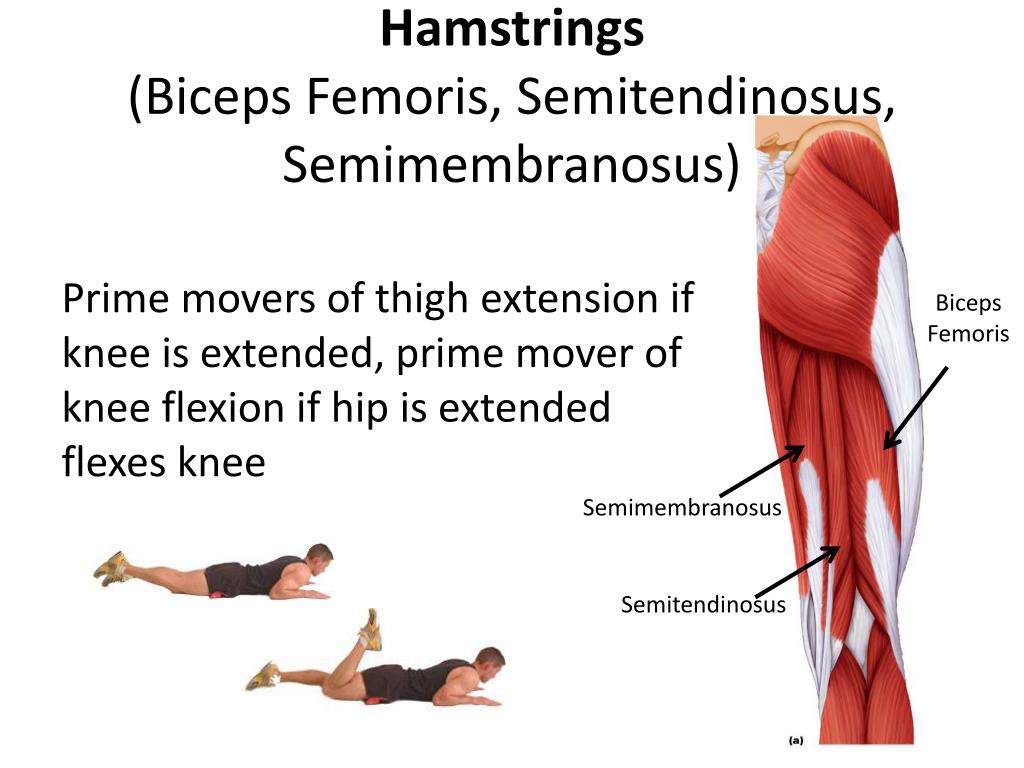

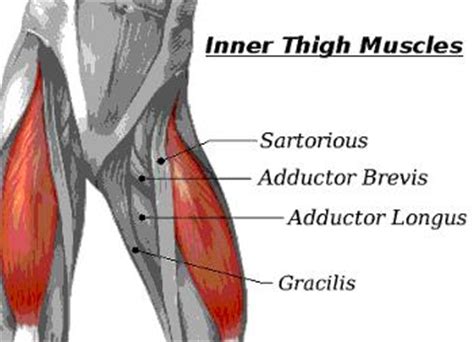
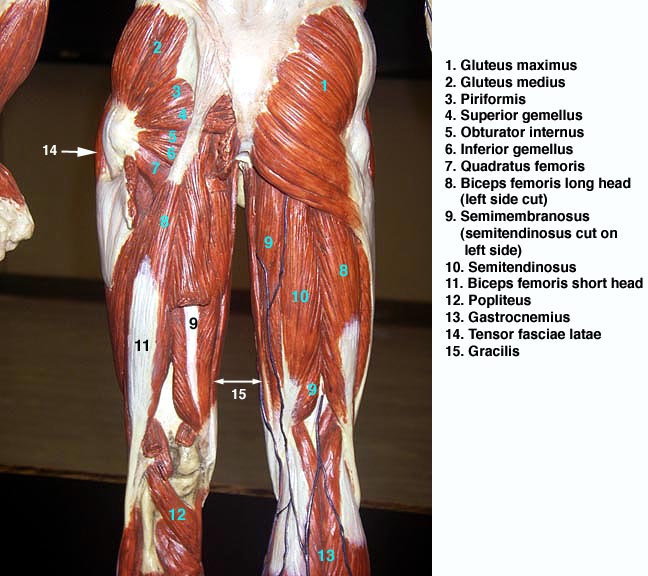

 Nikolaos Malliaropoulos, MD, MSc, PhD, Emmanuel Papacostas, MD, Olga Kiritsi, MD, Am.J.SportsMed.
Nikolaos Malliaropoulos, MD, MSc, PhD, Emmanuel Papacostas, MD, Olga Kiritsi, MD, Am.J.SportsMed.

 They can also be performed with an exercise ball by lying on your back and placing your heels on the ball, and then rolling the ball in toward you as you bend your knees and lift your hips.
They can also be performed with an exercise ball by lying on your back and placing your heels on the ball, and then rolling the ball in toward you as you bend your knees and lift your hips.